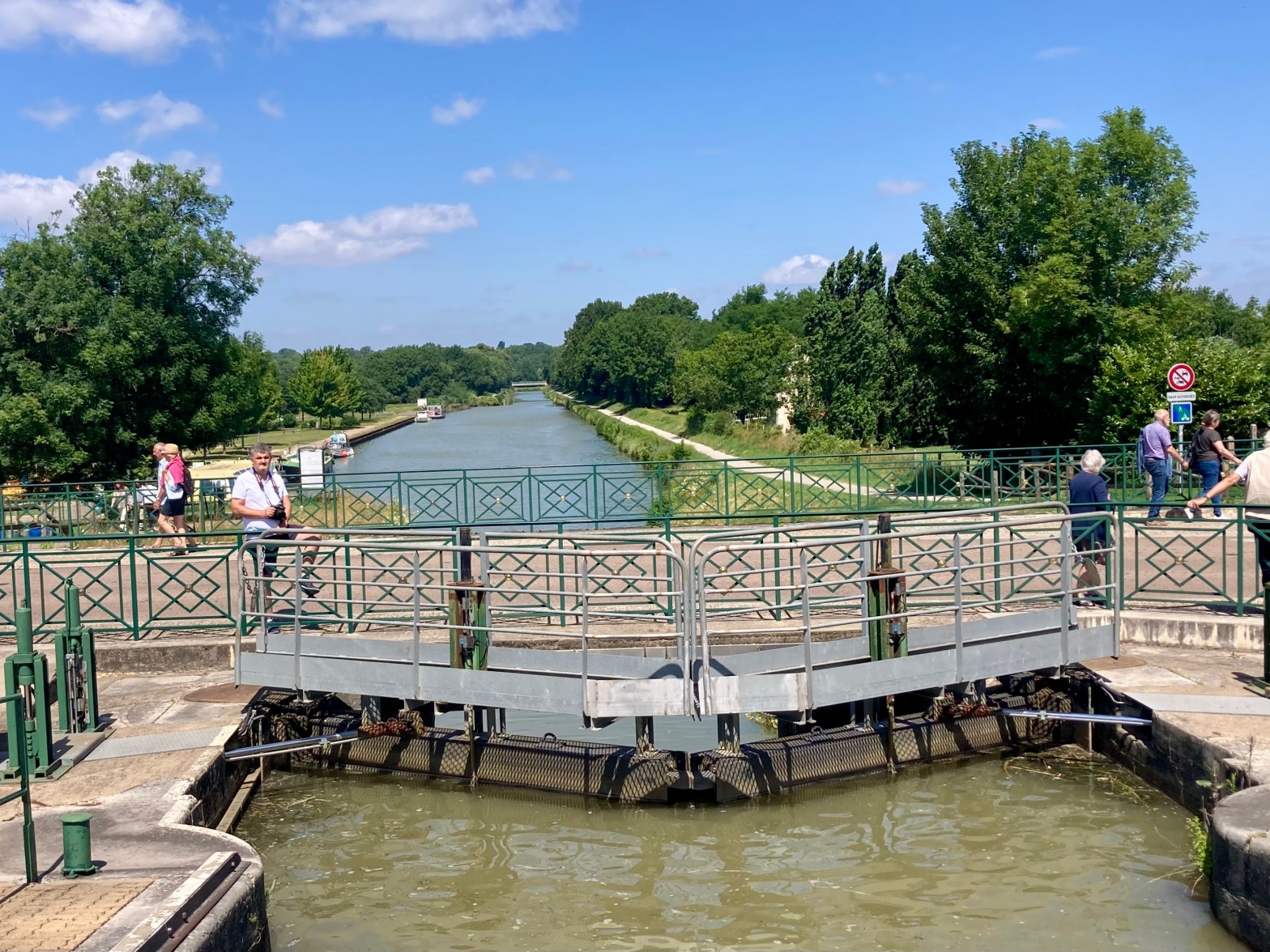8 days from Chevenon to Briare
2nd to 9th July 2023
The Loire is the longest river in France so I guess it is no surprise that the canal lateral to it is also rather long at 200 kilometres!
I was going to attempt to be a bit briefer with this second half of the Canal Latèral à La Loire – not because it was any less enjoyable – just that I risk boring you all. But it has had so many lovely and interesting moments that in the end it is as long as usual.
Just read as much as you fancy and then have a quick look at the photos maybe?
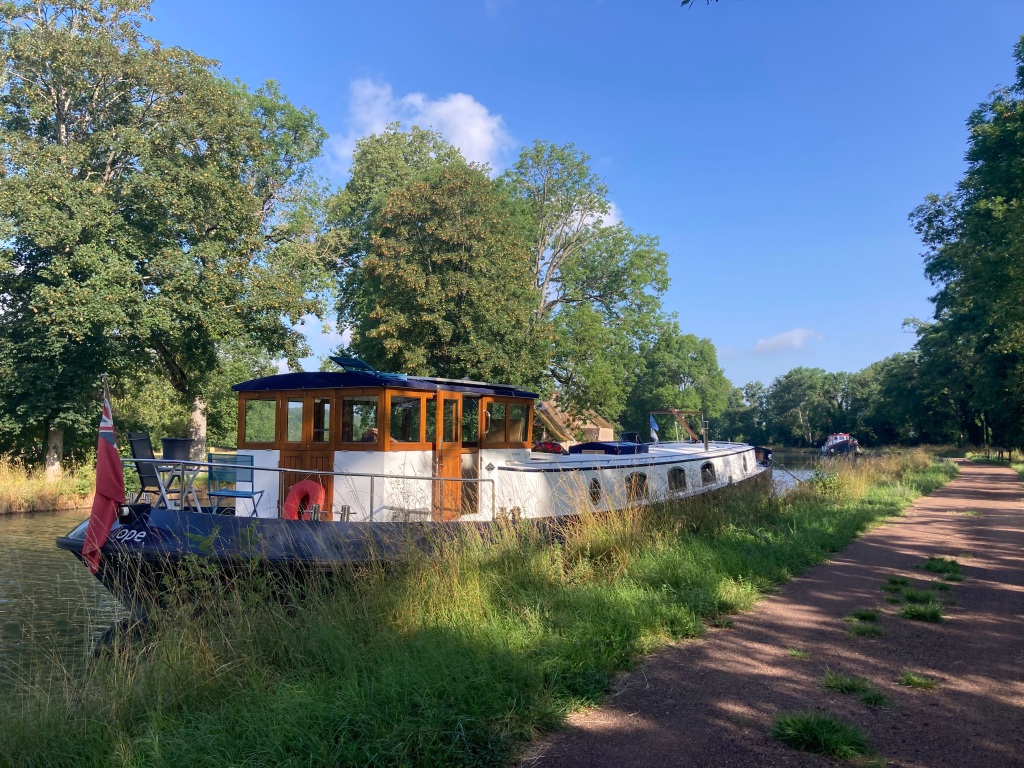
The second half of this canal journey begins at Chevenon, a delightfully shady and quiet spot where we spent the night and had been amazed by the medieval chateau in the village – see Latèral à la Loire part 1.
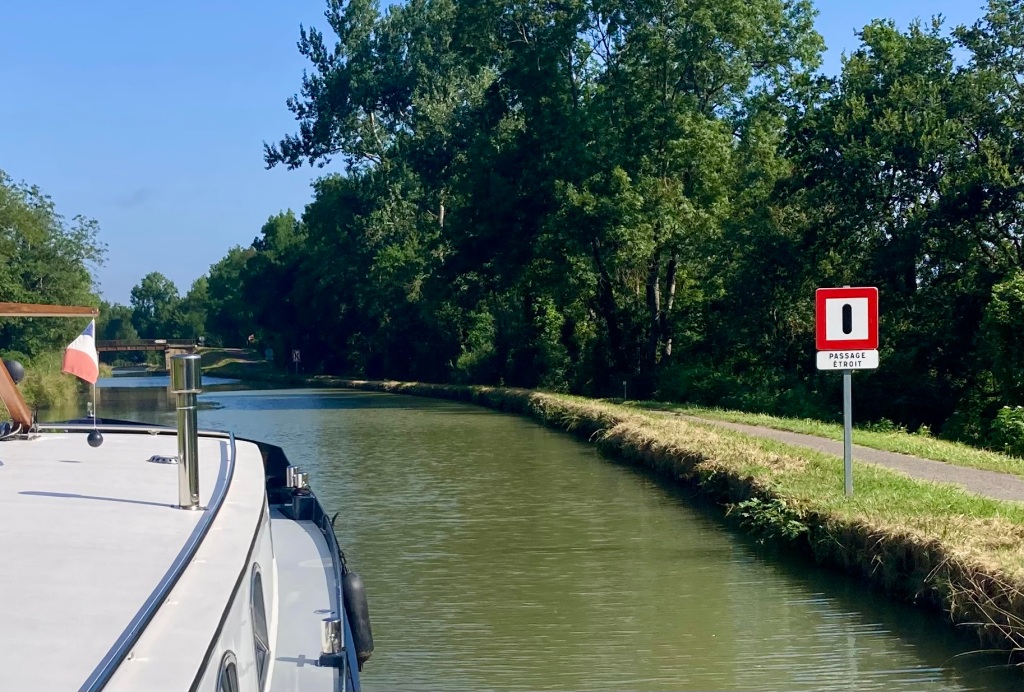

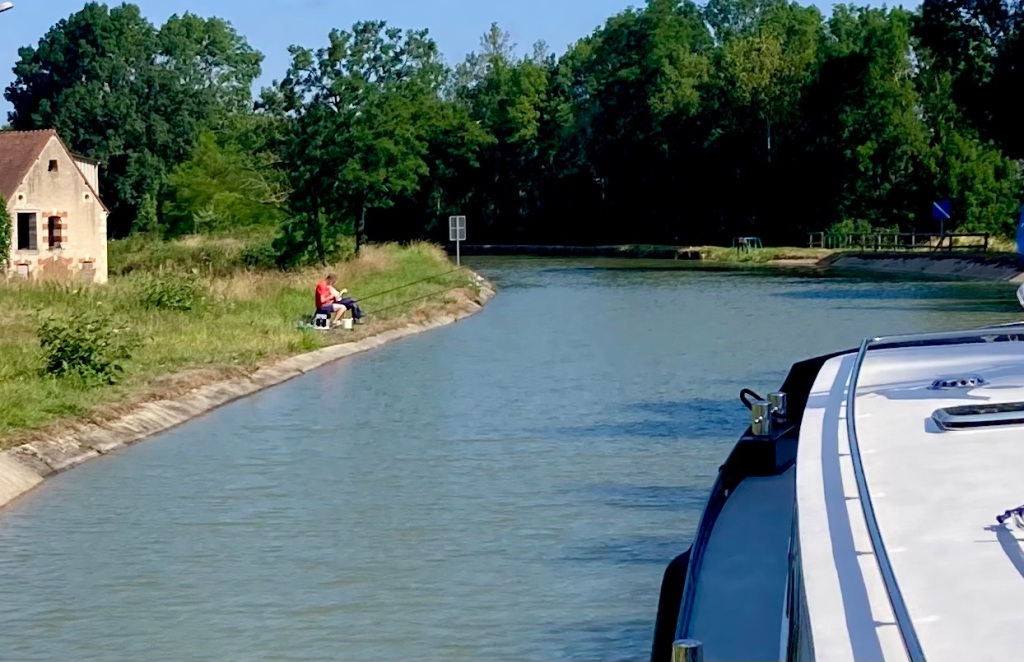
Various markers and ‘hazards’ we found along the way to our next mooring were these:- the signs for narrow (étroite) sections, one-way only sections, and the occasional fisherman or woman.
The latter sometimes requires the crew to sound the alarm with a cheery ‘Bon jour’. Some people are so engaged in their fishing, or asleep, that they don’t see us coming. We need to them to keep their lines away from the boat, otherwise they may get caught round the propellor, losing them their line (and maybe their rod), and causing us a bit of a mess to be cleared.
The next set of photos is a record of our descent through the double lock at Le Guétin.

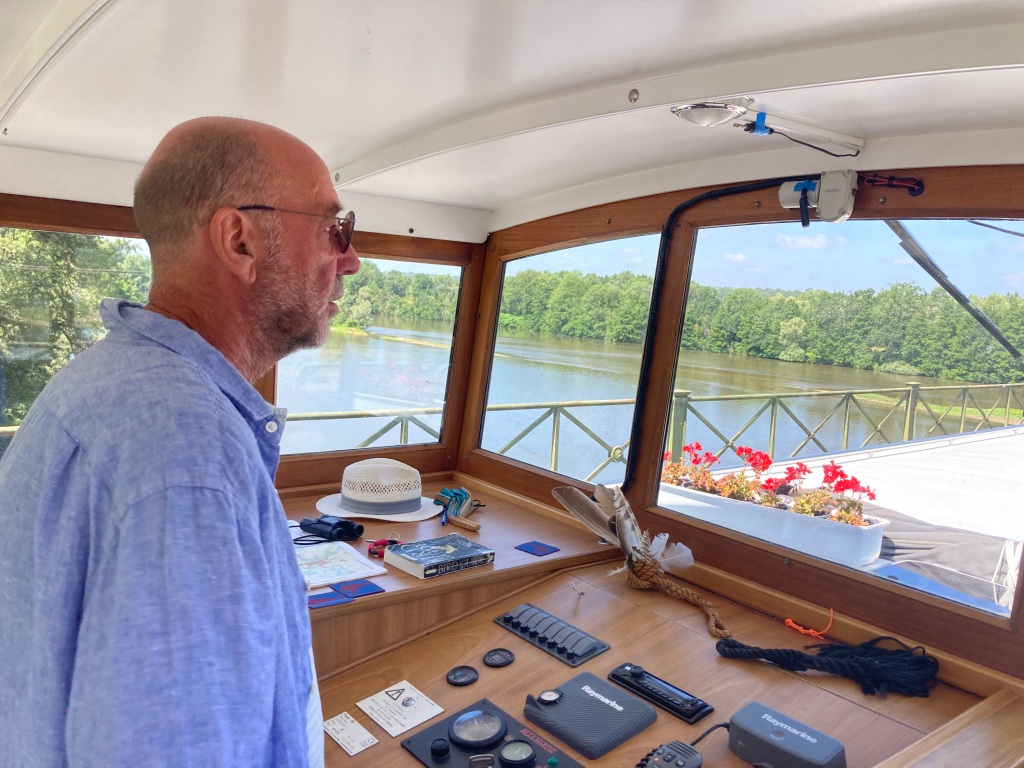
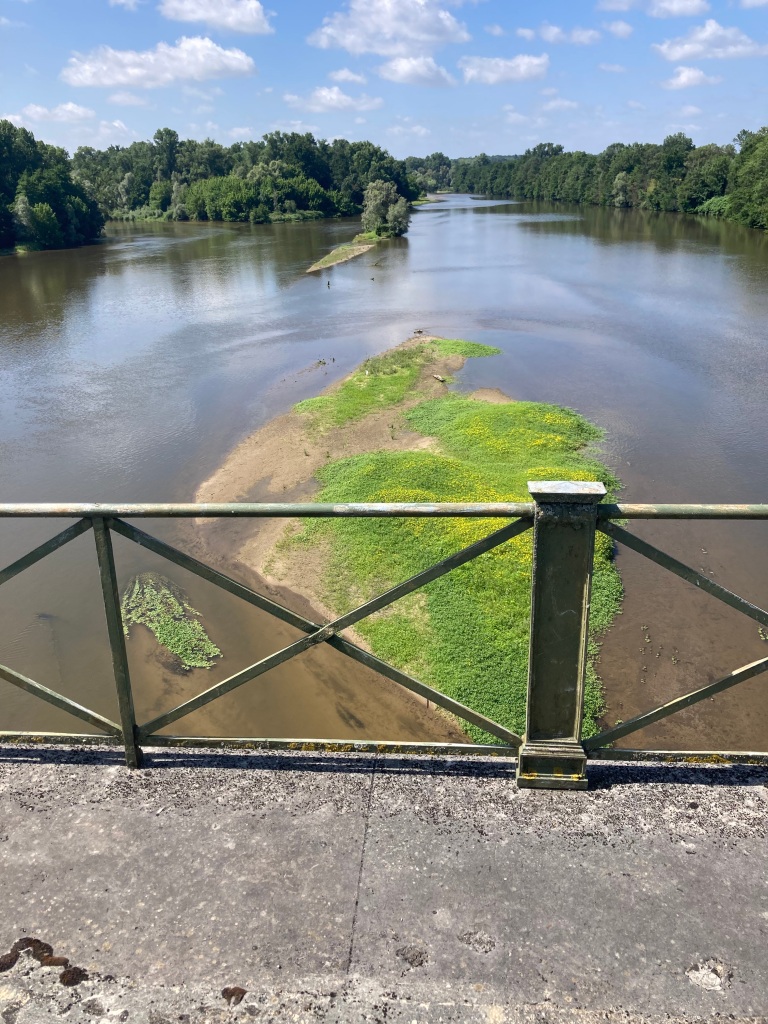
First there is an aqueduct over the Allier river, which joins the Loire a couple of kilometres downstream. While the Captain concentrates on the fairly narrow waterway across the aqueduct I could enjoy looking down on the river.
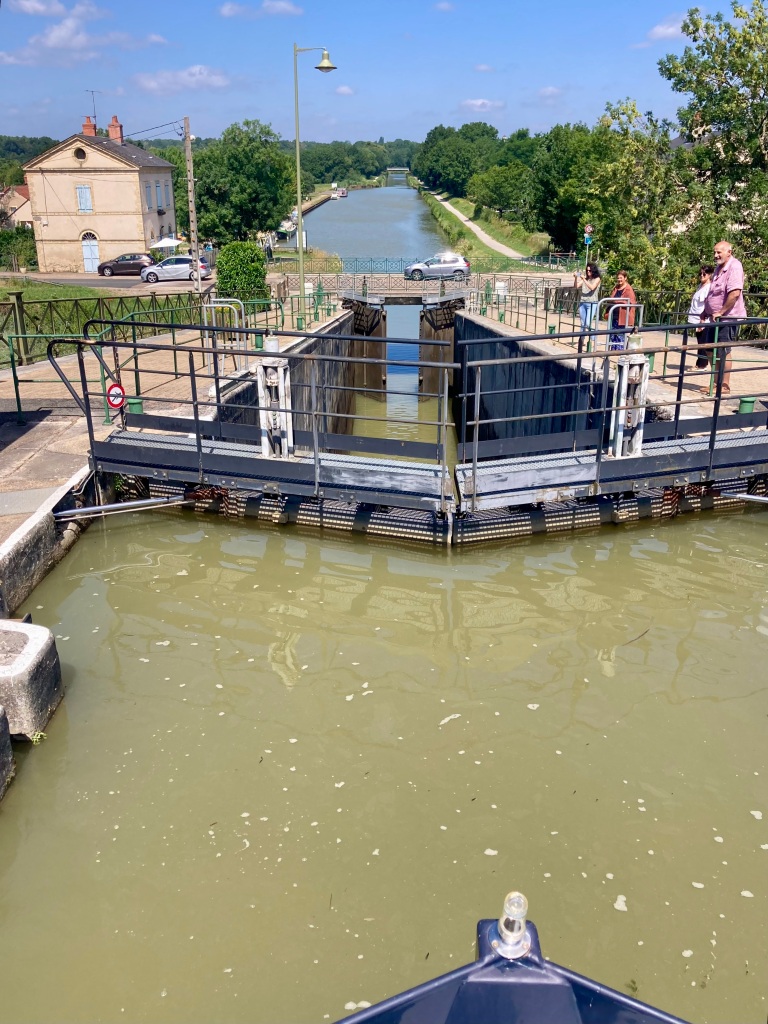
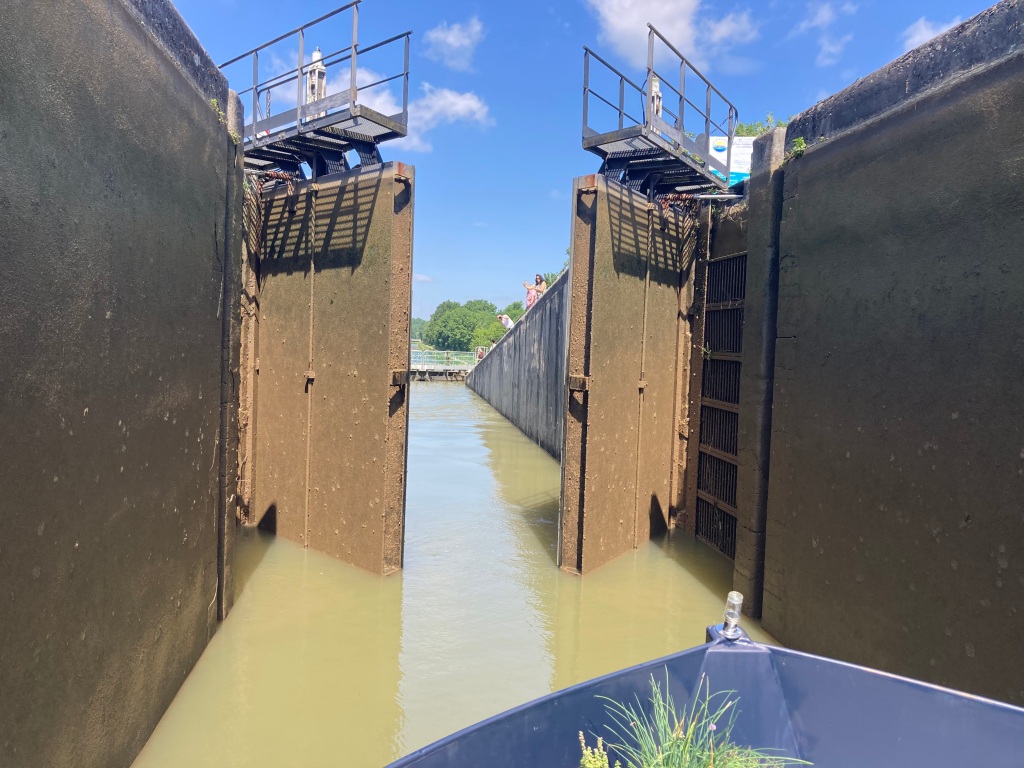

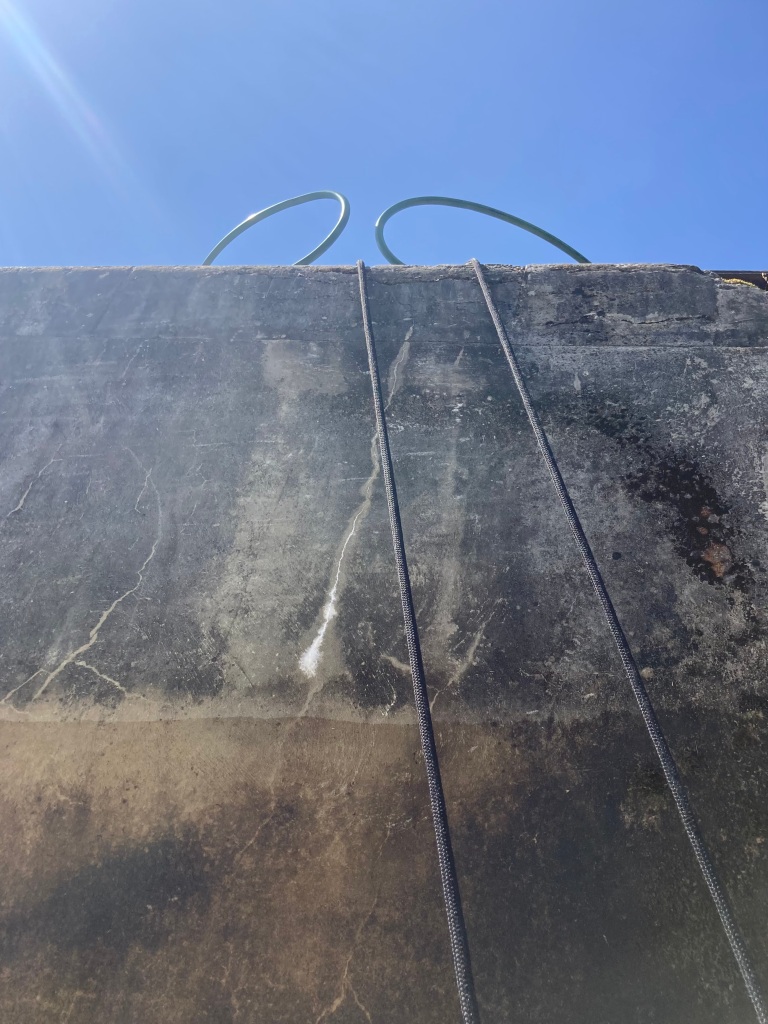
From the top lock you can see onto the empty second lock, and beyond to a nice empty quay wher we wanted to moor.
The top lock (1) empties into the bottom lock (2), dropping Calliope down to the level of water now in lock 2. The gates open and we move into lock 2. From there it is even easier to see all the space waitinfg for uis to moor up.
I also include a photo of my ropes. In this lock the bollard is quite a way above me and it is hard to see it, let alone throw a rope round it, but here is an invention I had not seen before. The railings round the lock at this point are shaped to drop your rope down around the bollard! It worked. Although had I missed the éclusier (lock keeper) – a pleasant helpful lady in this case, was on hand to help.

Three minutes after leaving the lock we were tied up and ready for lunch.
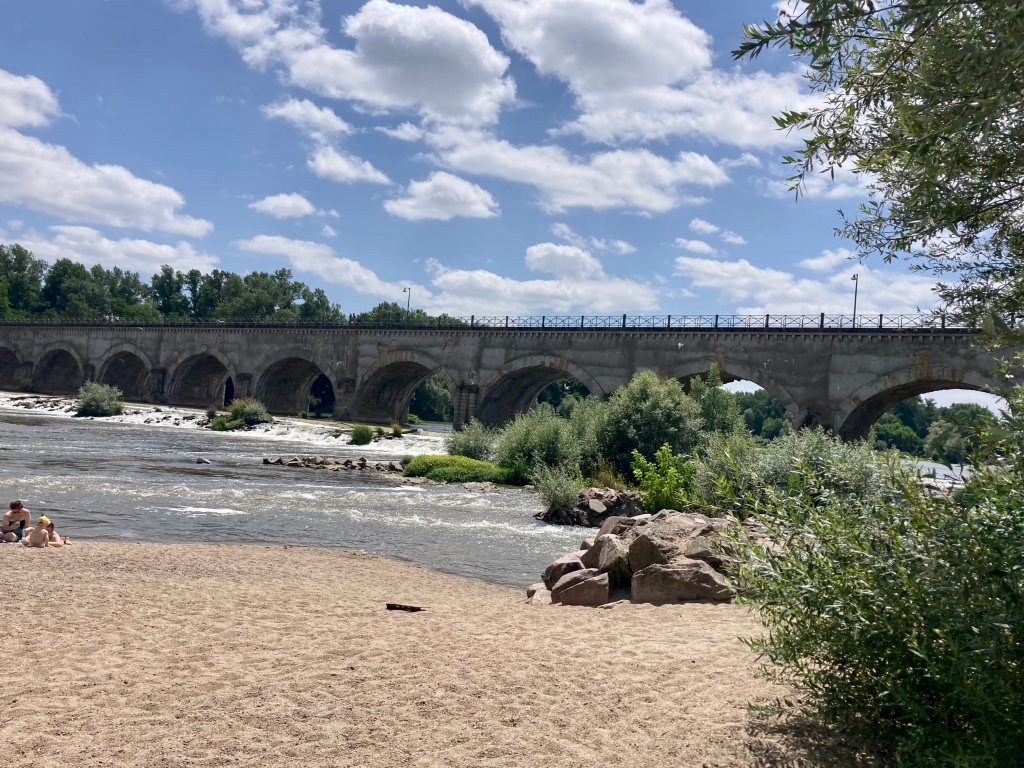
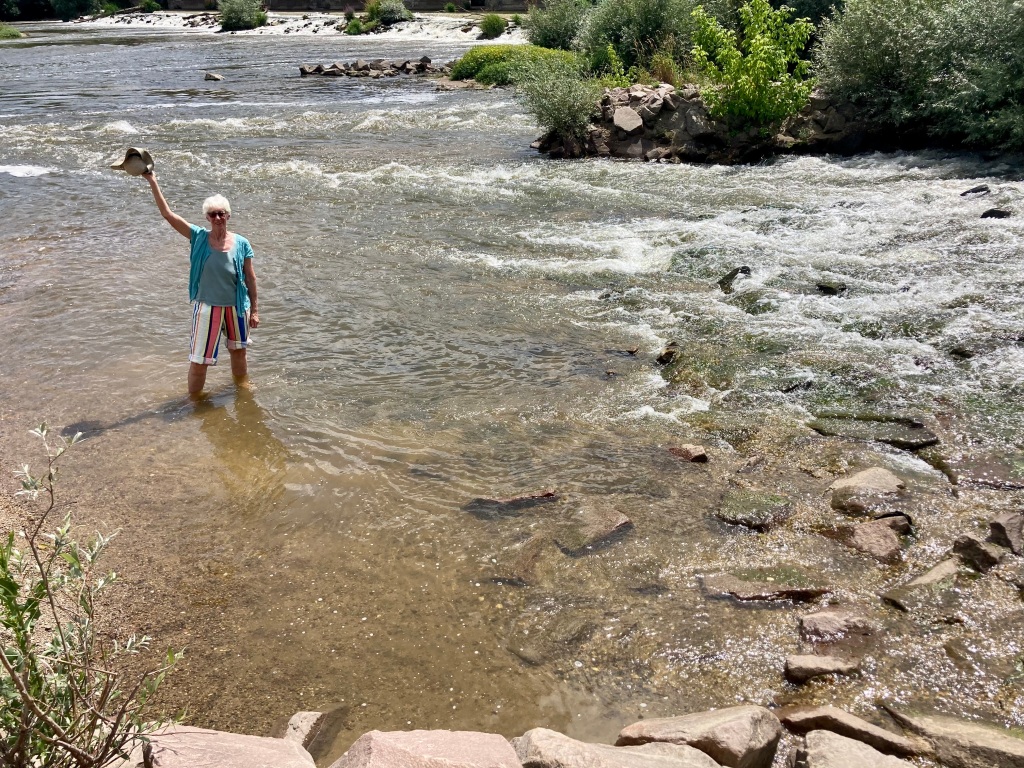
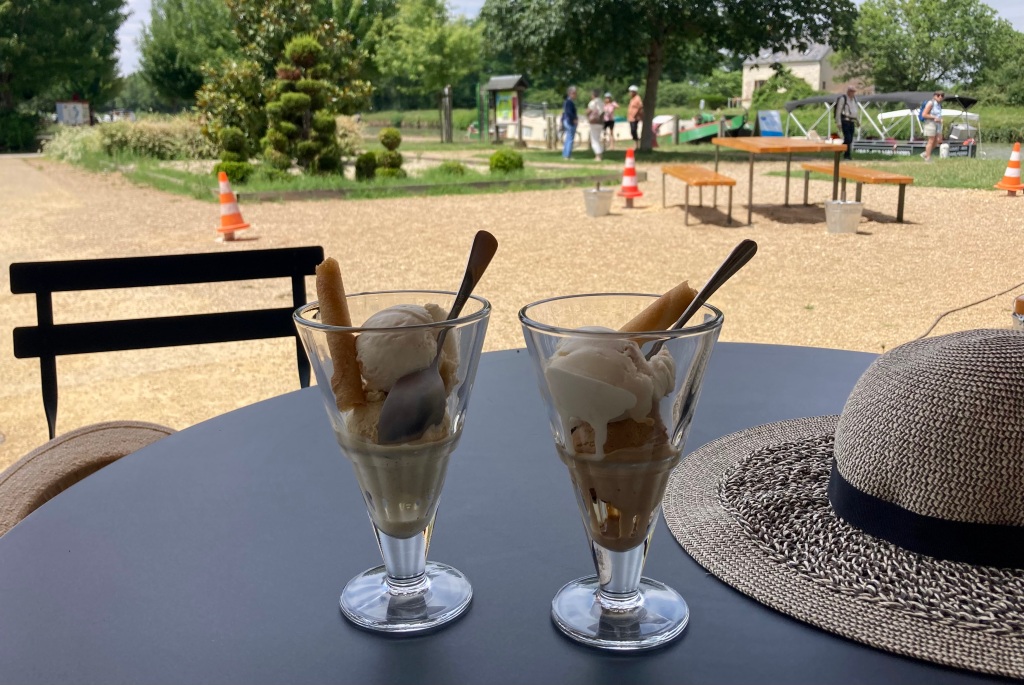
And a couple of hours later, after a snooze, we were ready to explore the small village of Le Guétin. Sadly it is a place that has almost as many houses and businesses closed up as there are open, though there are a couple of restaurants and a café near the mooring where we decided to fill glasses with ice cream instead of wine for a change.
The ice cream came after a trip to the beach at the edge of the Allier river. In the winter it must be covered up, but right now a sandy beach is revealed, next to some lovely shady trees. It is very popular with families for picnics, swimming, parties and, for me, paddling.

Back to Calliope for a gentle evening aboard, amazed that no other boats have turned up to moor along this long quay for the night.
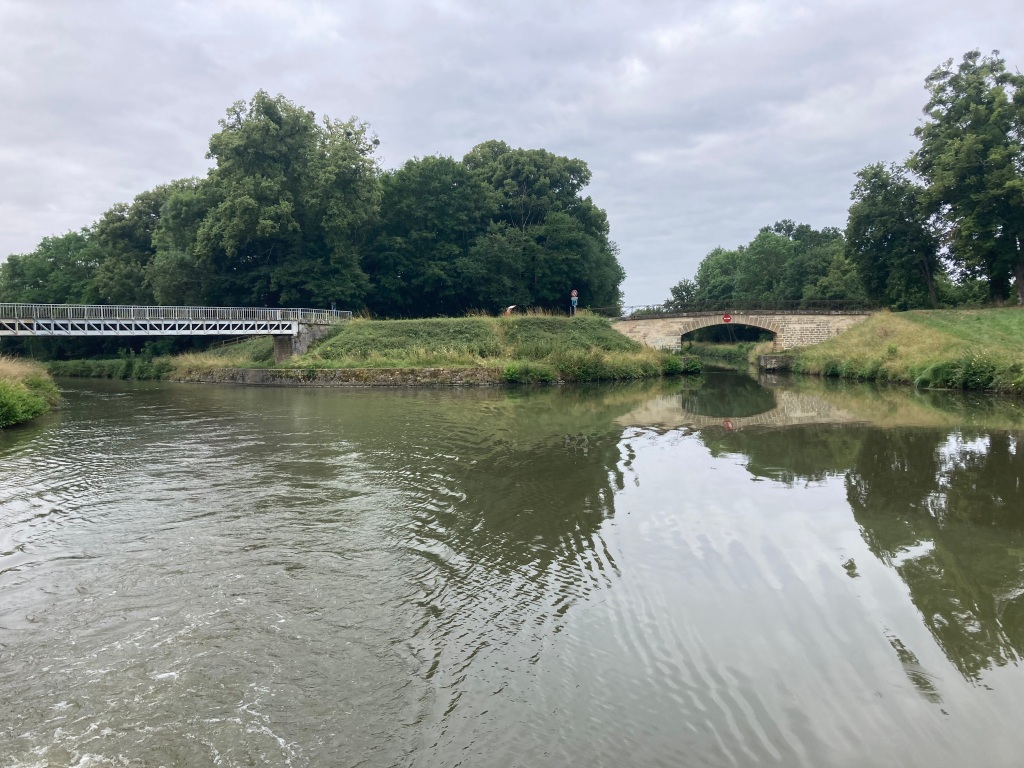
It was quite grey when we set off from Le Guétin. But not so dim that I missed the joining of another Embranchement – this time an out of use one , the Lorrains Branch canal.
It leads to an unusual round lock which once led into the Allier river.
Along the way we saw many examples ofd these ‘deer steps’.
Deer often fall in the canal, or jump in and cannot get out, until they reach one of these steps. We are so glad they exist!
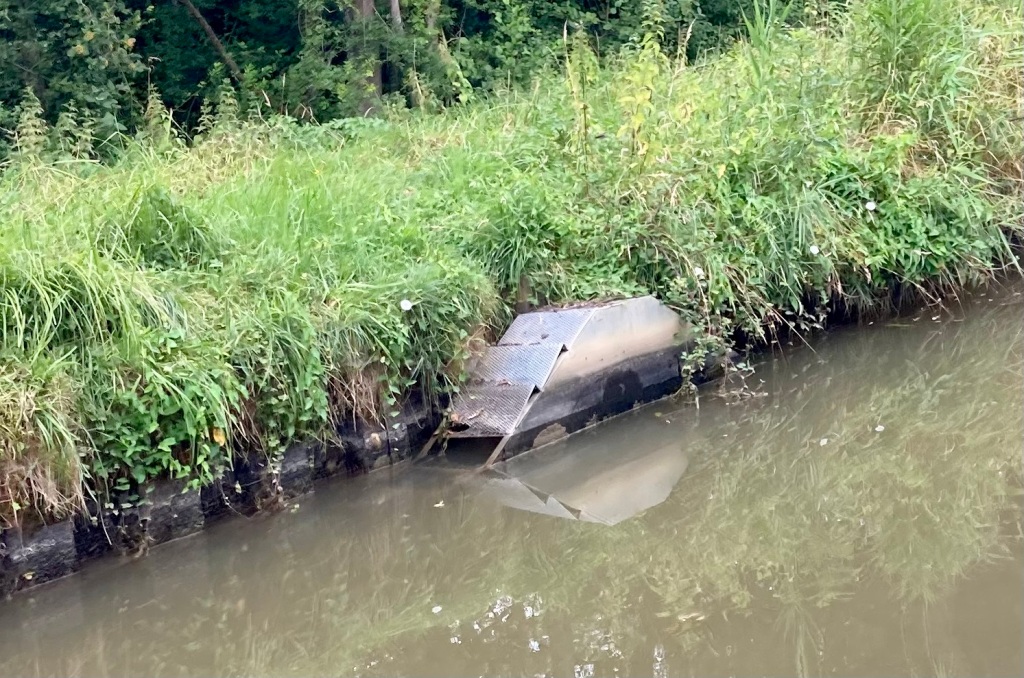

In fact a few days later we came across two deer swimming in the canal – you can just see them in the photo by the wake following them as they swim.
Only a few yards further one they were able to climb out. Phew!
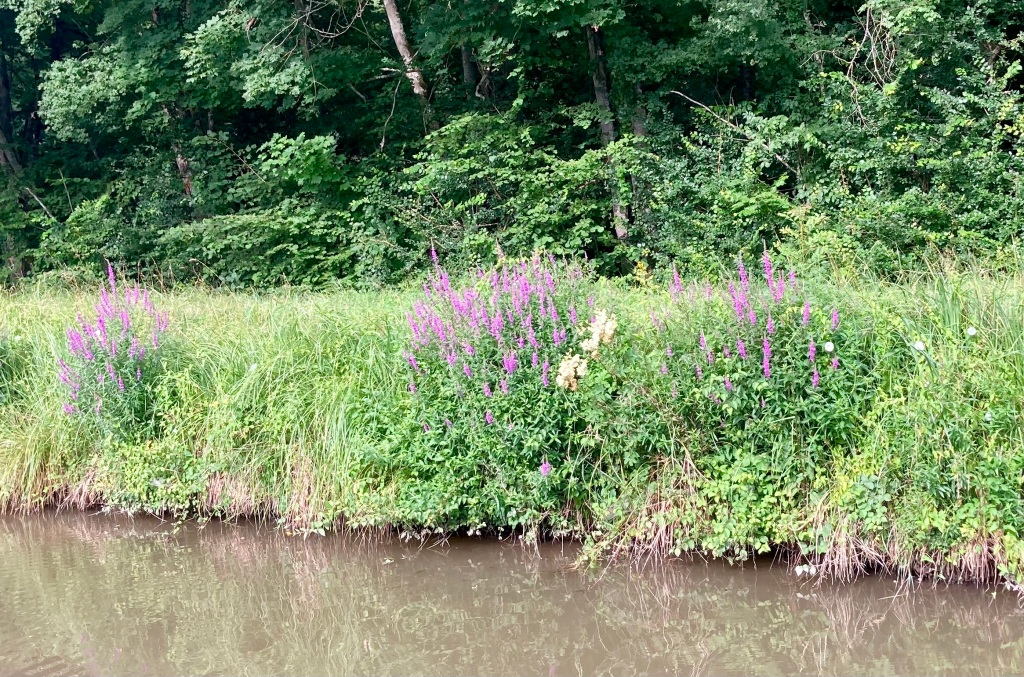
Everywhere there were flowers – I can only capture an idea of what not is like to travel along such an elongated garden! I cannot get the flowers in focus as we move, so this is almost a Monet-esque representation.
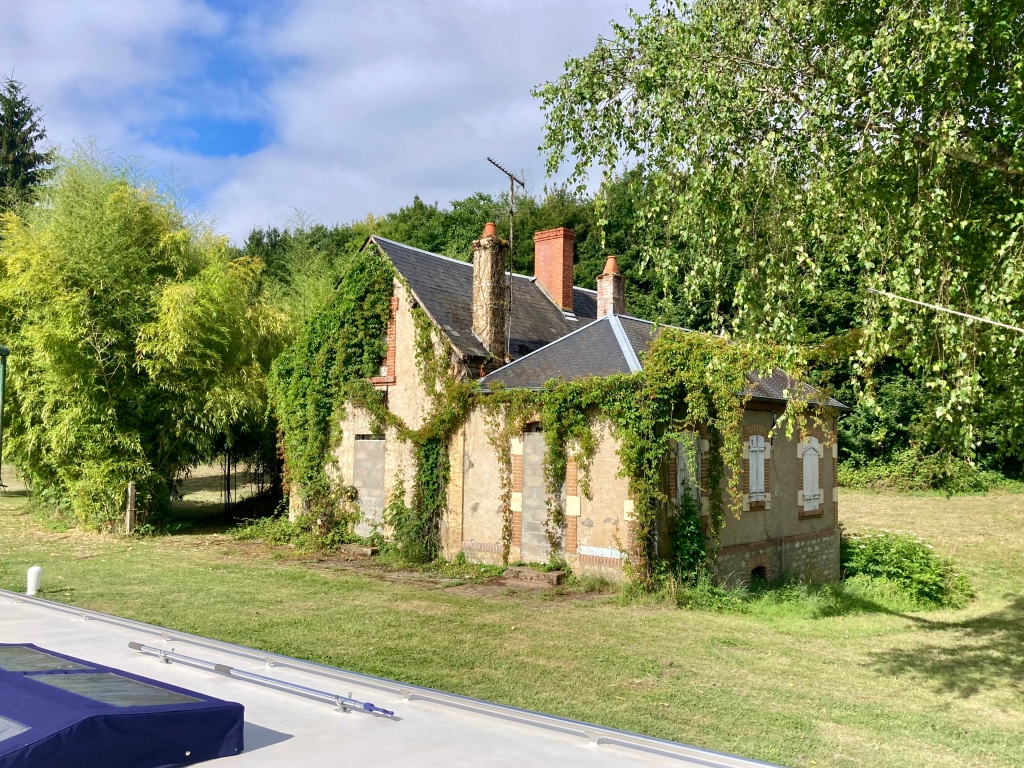

5 kilometres after starting out that morning we were at our first écluse (lock), Laubray. The old éclusier’s house managed to look attractive, despite the bricked up entrances. The functional hut provided for today’s éclusiers was less so, but it was good to see the original blue sign from the house now attached to the hut.

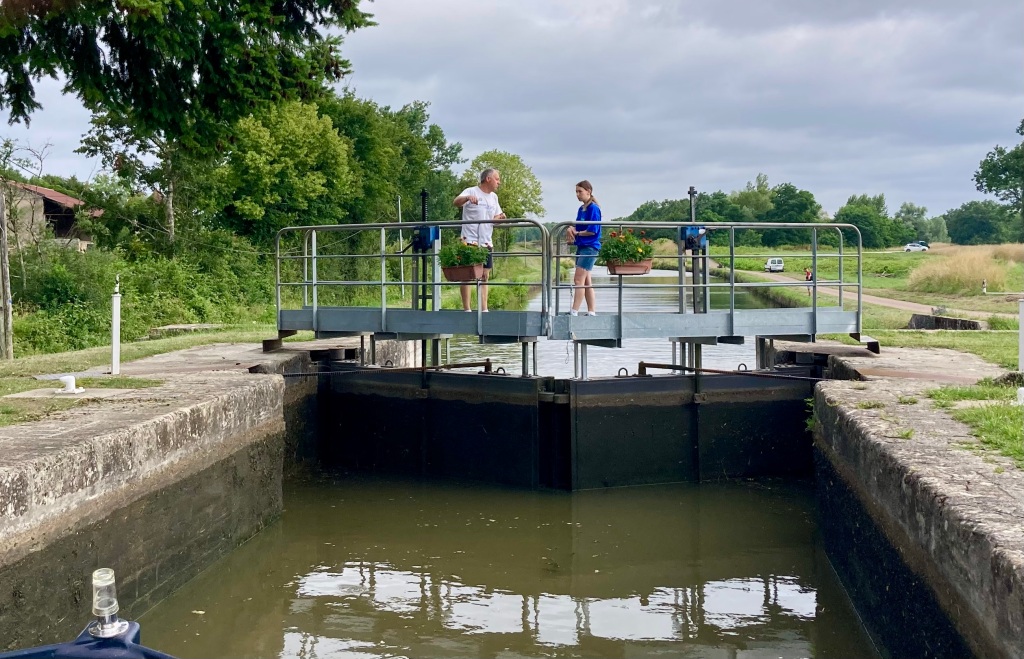
At this time of year, summer, students are brought in for temporary work as éclusiers during their holidays. At Laubray we met one being trained – her first day. It took a bit longer than usual to go through the lock, but it was interesting hearing her instruction – some of which our French was able to understand!
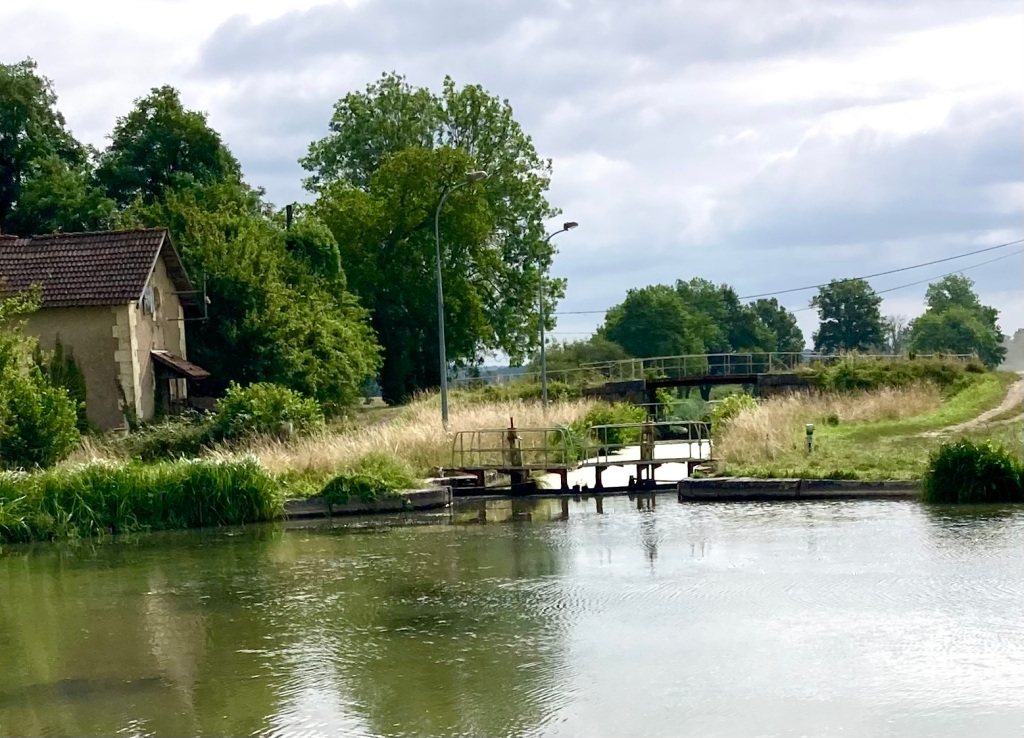
As we continued downstream we passed yet another Embranchement – this time one that was a short 2kms bief (stretch of water) to the Loire. How wonderful to be able to go out on the river! Apparently, despite its dilapidated look it is still possible to call up he VNF and ask to be let through the lock. My VNF Navi app tells me the lock is available and gives me a phone number.
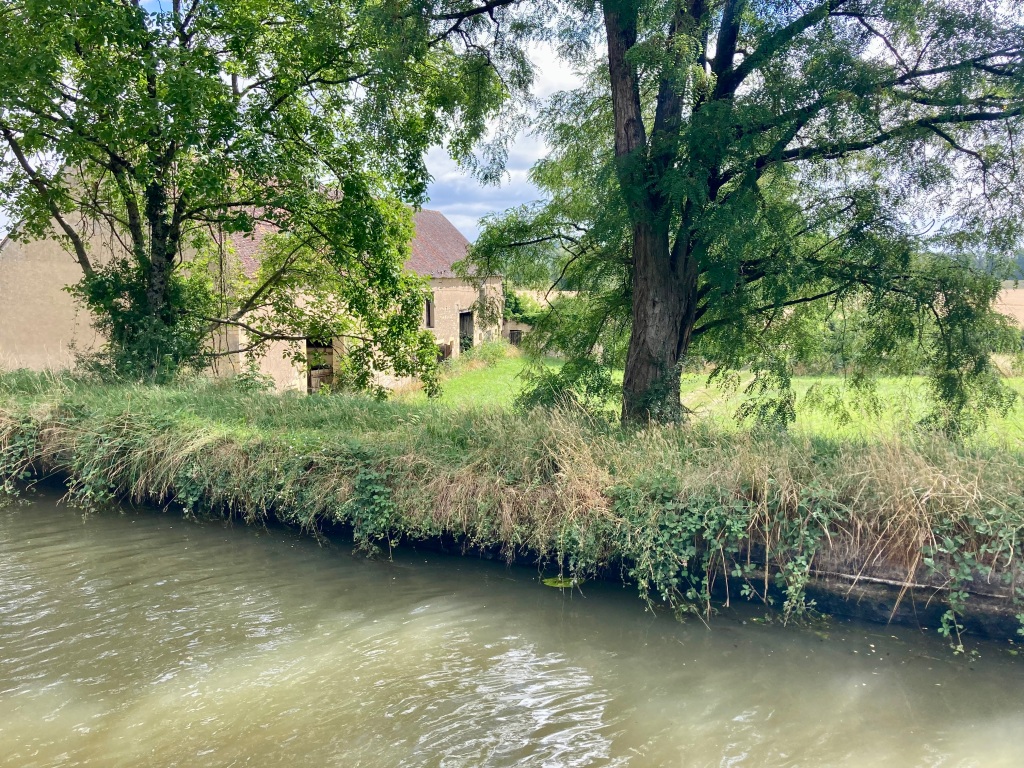
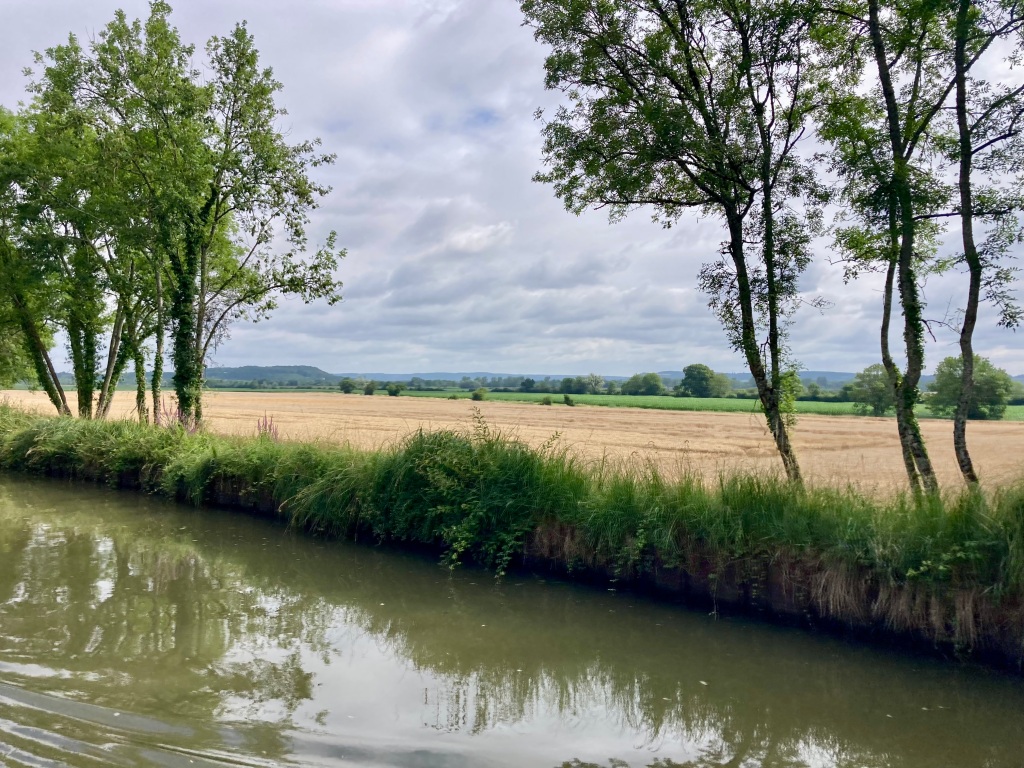

The farming world was opening up before us, both buildings and fields. Most of the farmhouses still appear to be lived in, with tidy farmyards around them.

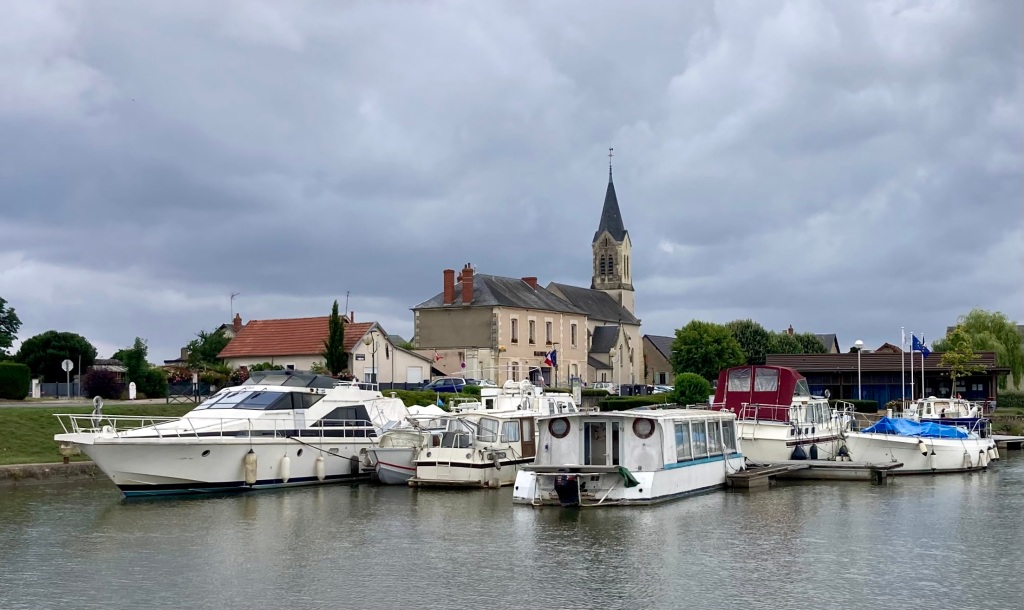
And then a change again as we came into Marseilles-les-Aubigny, a surprisingly big port in the middle of the countryside. In addition to mooring for many older barges, mostly converted into homes, there was a port de Plaisance for leisure boats.
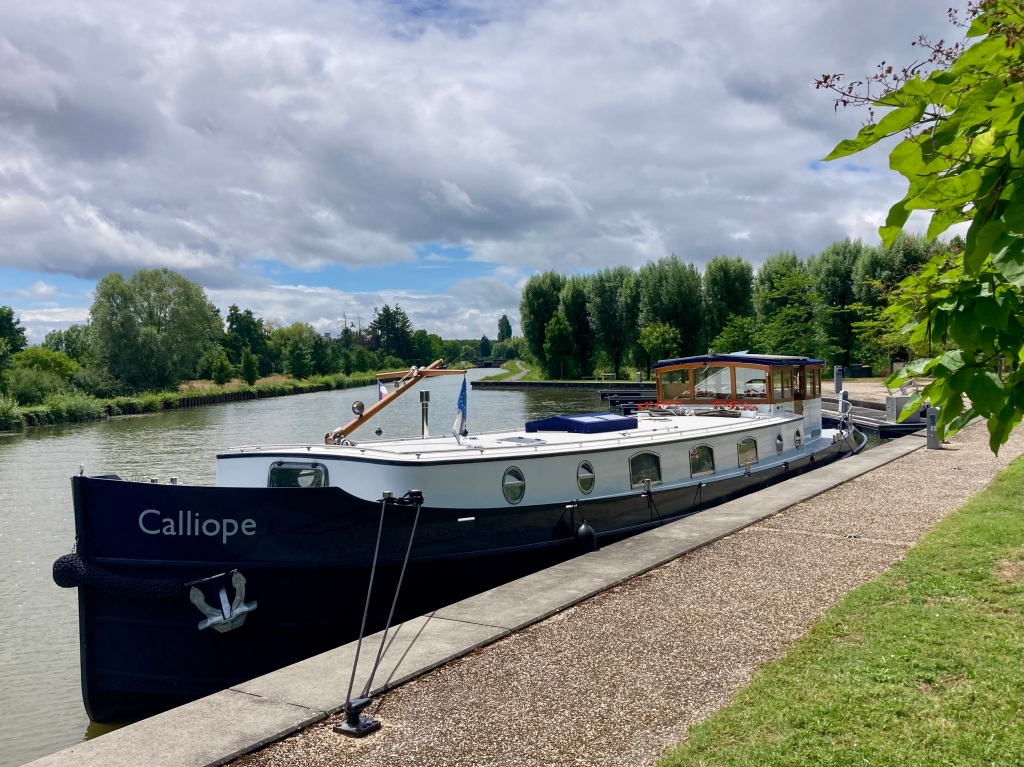
We continued for another couple of kilometres though to spend the night at a quieter village called Beffes and enjoyed a pleasant and more rural mooring.
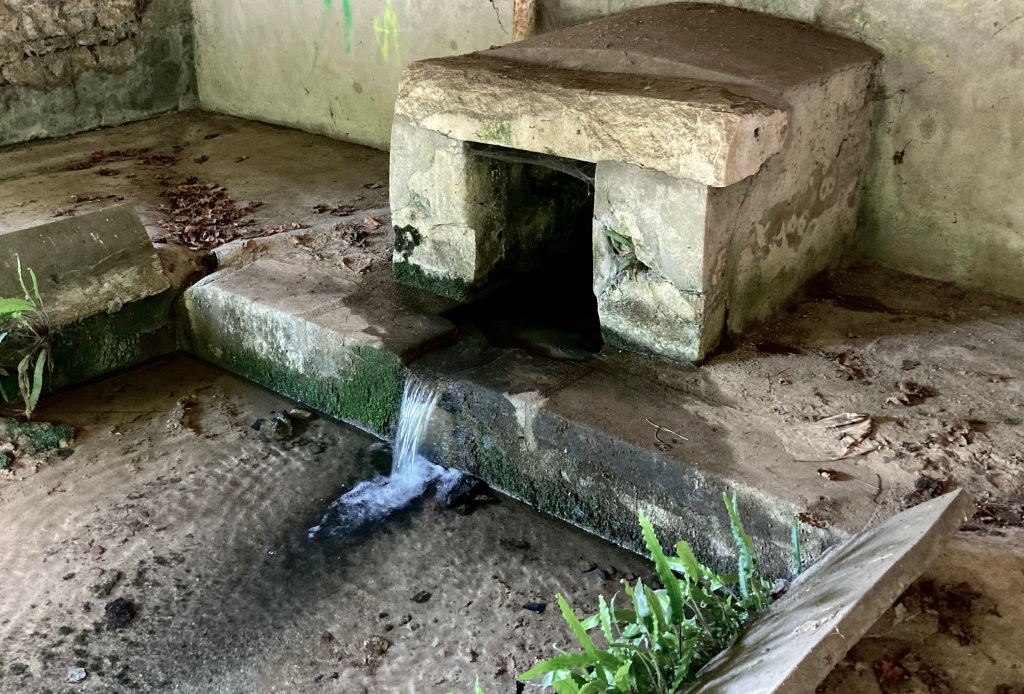

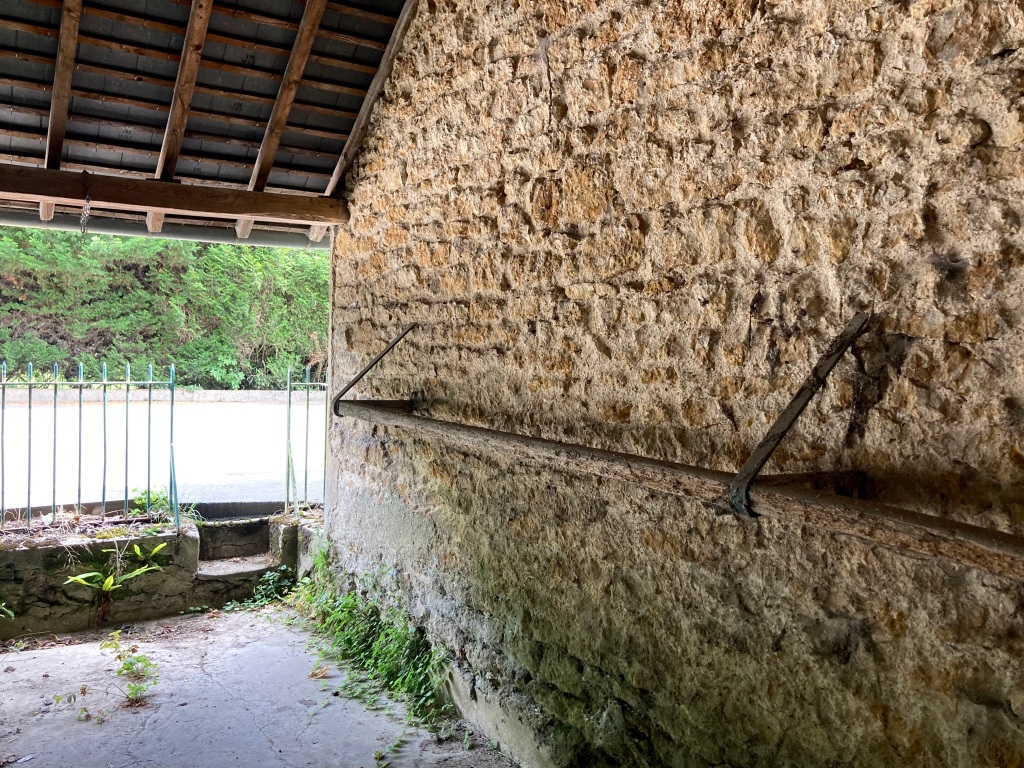
A walk into the village unveiled another lavoir for me to photograph. It was obviously built around a stream that was still tumbling in at one end, through quite a monumental entrance! Also good to see one of the old original drying rails still in place.
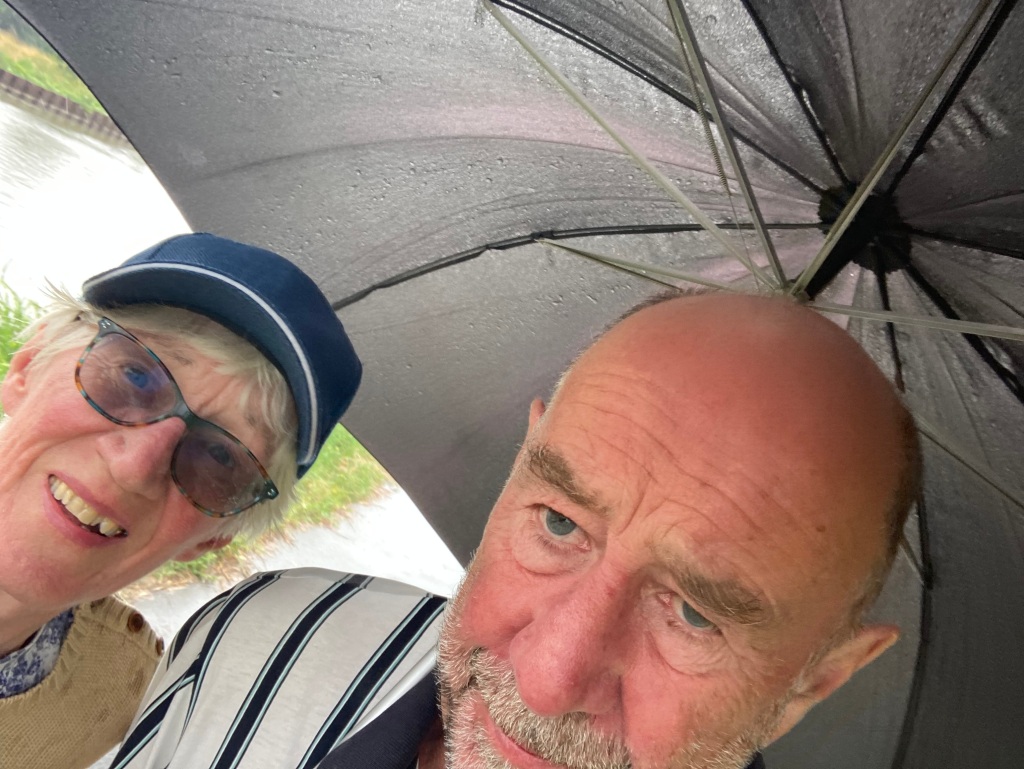
On the way back from our walk, where we discovered that the recommended restaurant was now sadly closed, though the boulangerie and Proximarche were happily still going strong.
It then began to pour with rain – not the Captain’s idea of a fun walk!
Undeterred I ventured back out later to the other side of the canal and the rest of Beffes village ….
…. where I found another lavoir! This time more modern and brutalistic in design.

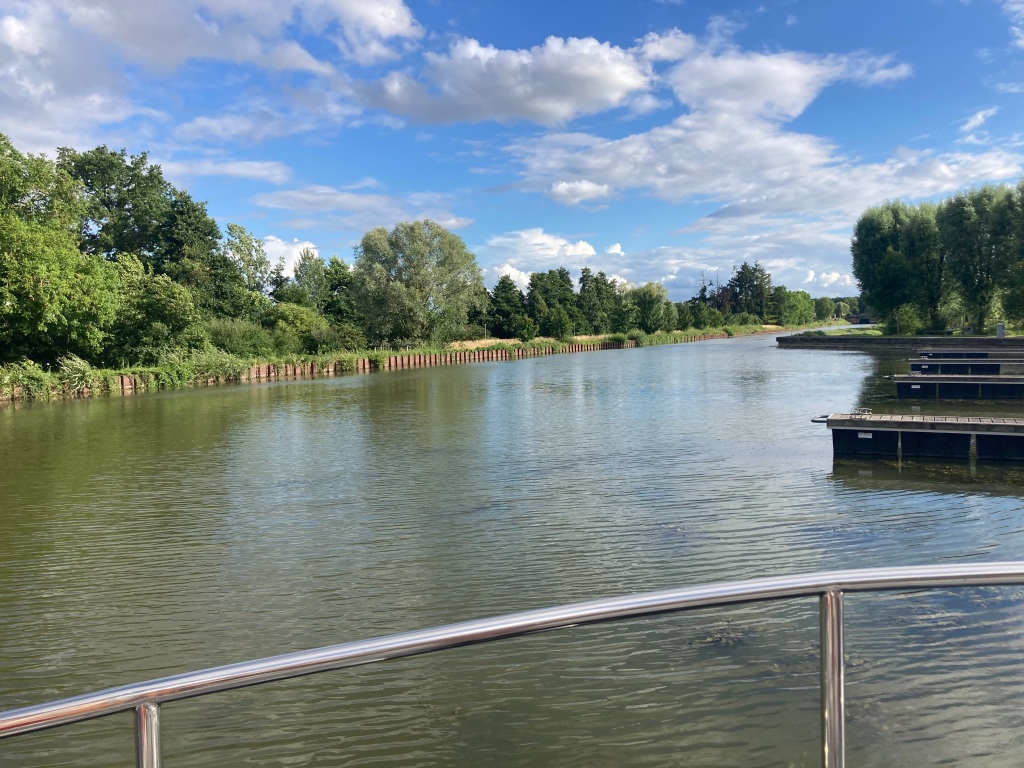
The sun returned an hour or so later and the day ended pleasantly on the back deck.
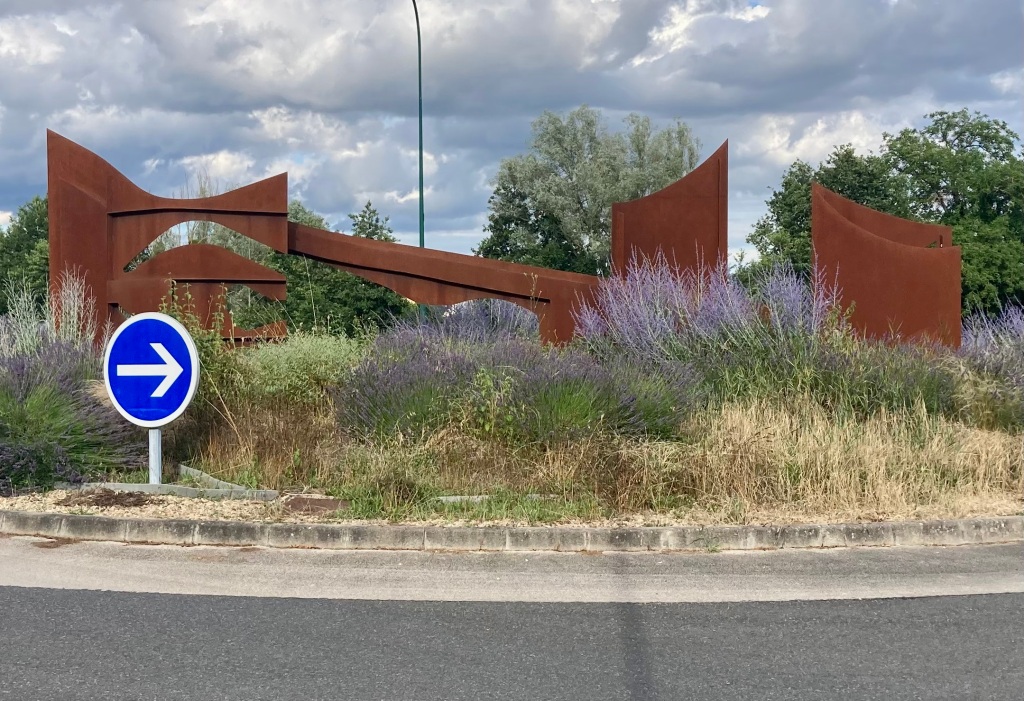
Just one more thing before we leave Beffes. The aforementioned roundabout had a huge metal sculpture amongst its flowers.
We were not entirely certain what it represented, maybe a barge?
When the engine was started in the morning the Captain thought that our starter battery, after 9 years good use, was nearing the end of its best life. He thought it should be replaced now, rather than waiting until it died and we suddenly found ourselves stranded. We pondered on how to accomplish this as we moved on to Herry.
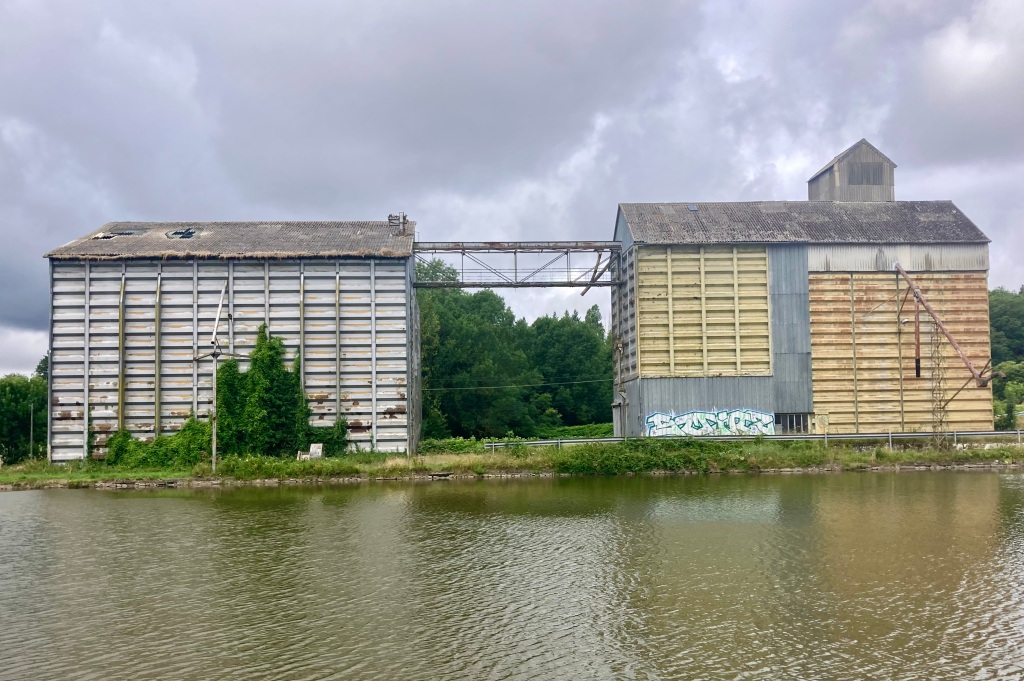
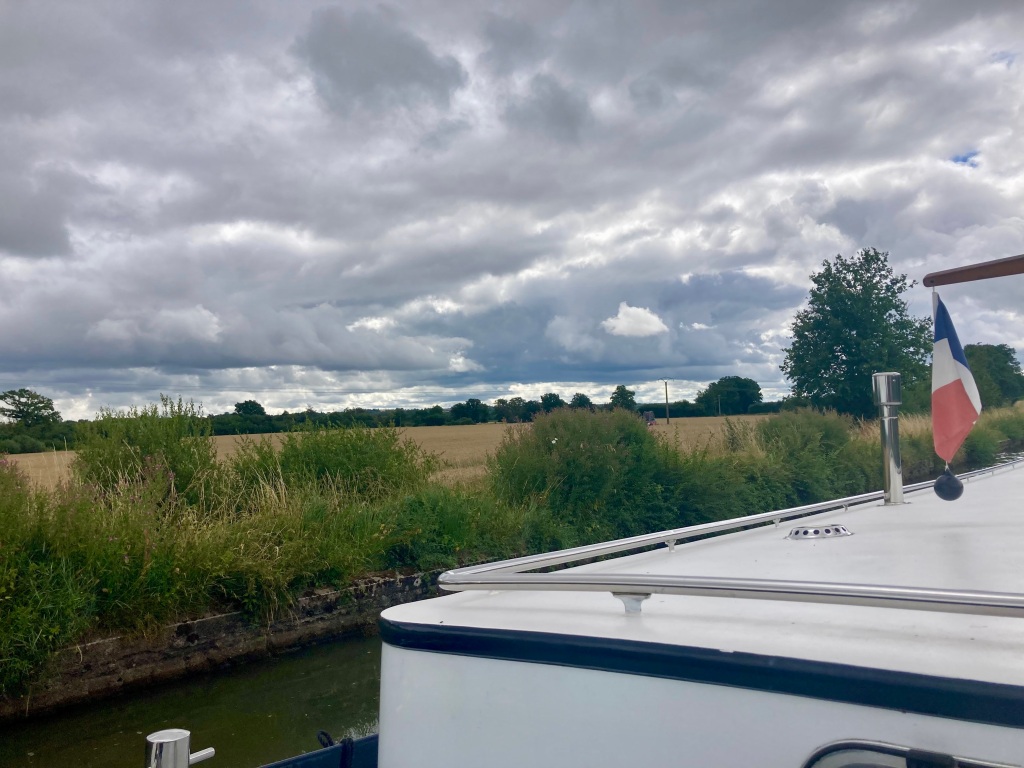
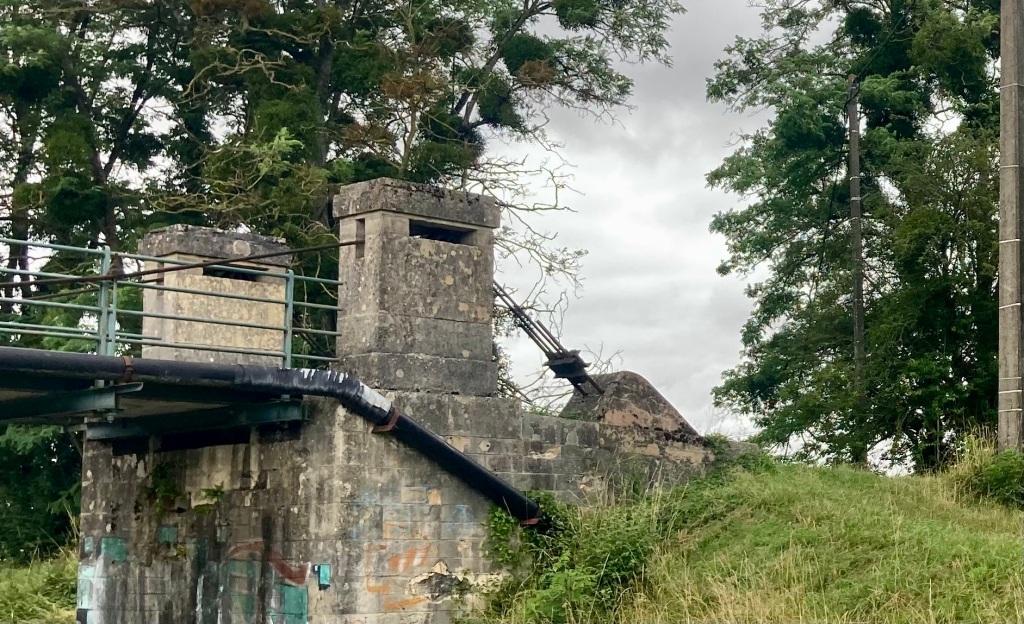
The canal had various characters that day – some old industrial buildings, now defunct; farm land reaching to the horizon; old bridges, some with unusual suspension.
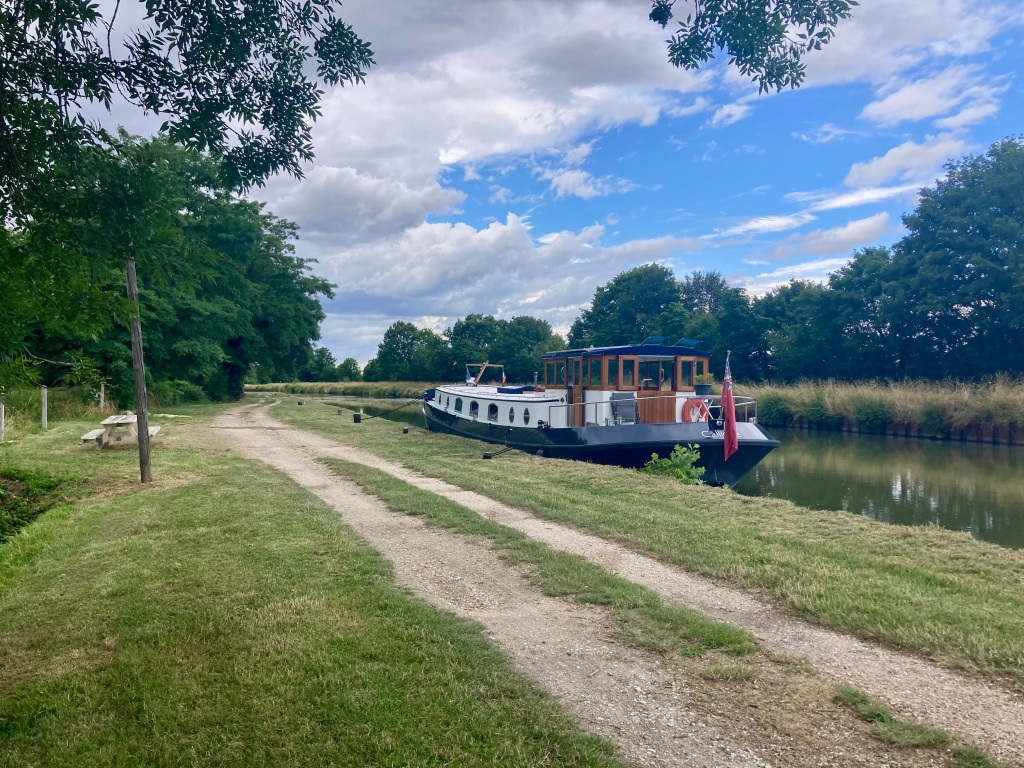
When we got to Herry we had another quiet rural grassy place to tie up for the night. It was lunch time so as usual I was off to the boulangerie.
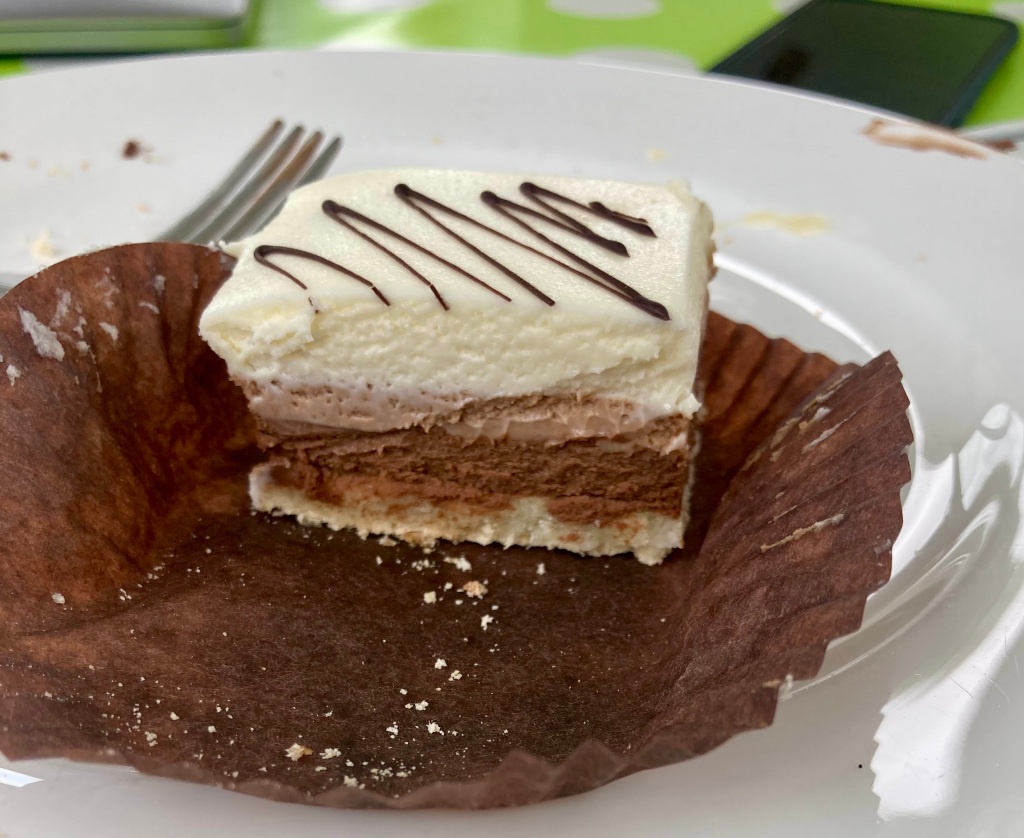
And because it was the 37th anniversary of the day we moved in together to start our lives as a couple, I bought an anniversary cake to share in celebration!
Three layers of different chocolate mousses – it was a good cake!
Now we turned our minds to the battery again, I remembered that when we passed through Marseille-les -Aubigny we noticed a chantier business (boat building and repairs). I gave them a call, although it turned out to be easiest to communicate by text message where we could both use Google to translate what we wanted to say! It worked and a new battery was ordered to arrive next morning.

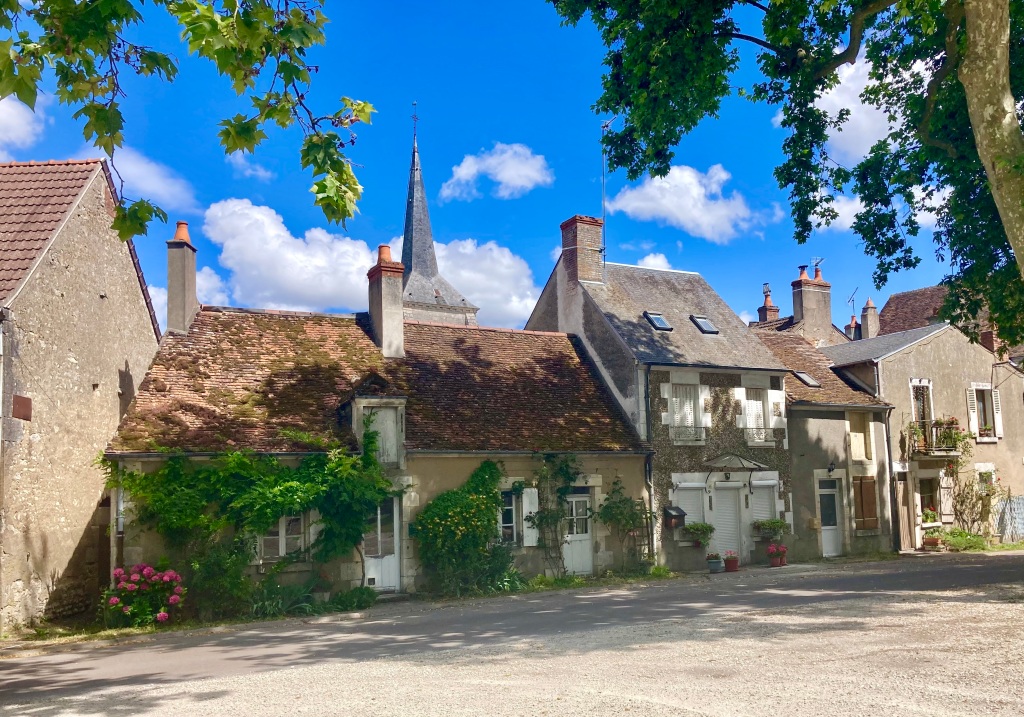
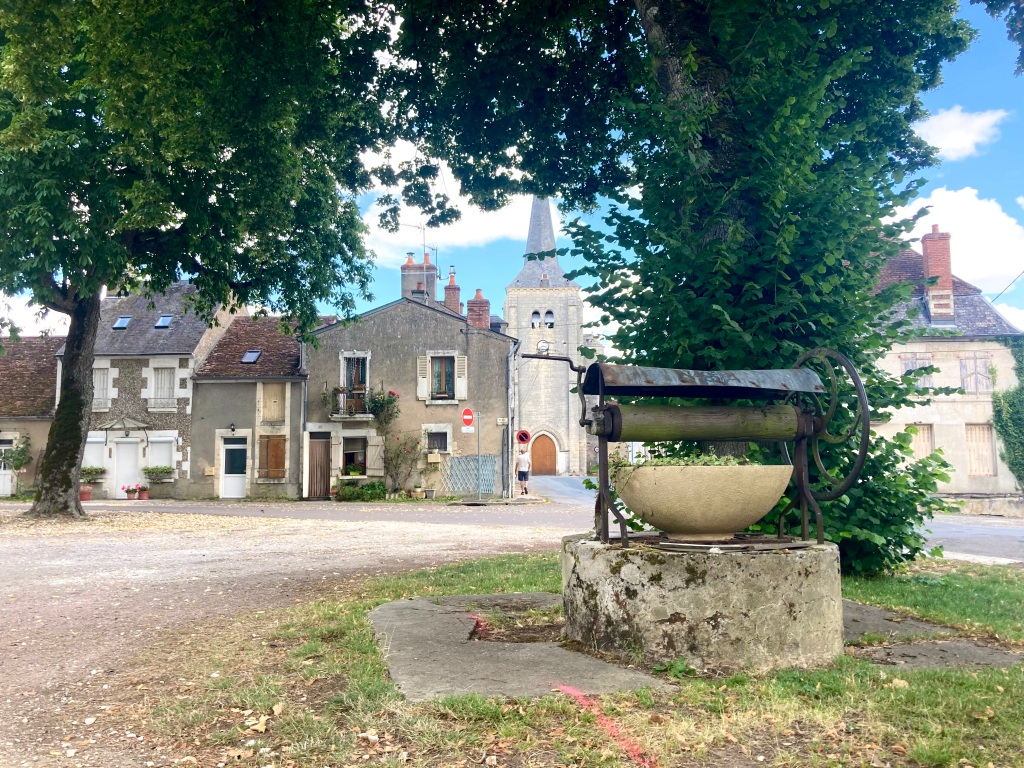
In the meantime we had time to walk around the village, which in the past looked like it was very an important and thriving commune. There are still quite a few grand houses, but sadly many of the smaller ones are now empty. The old priory (above) is still there, attached to the church.
There is still a school, a church, a post office, tabac and of course a boulangerie, so some vitality remains.
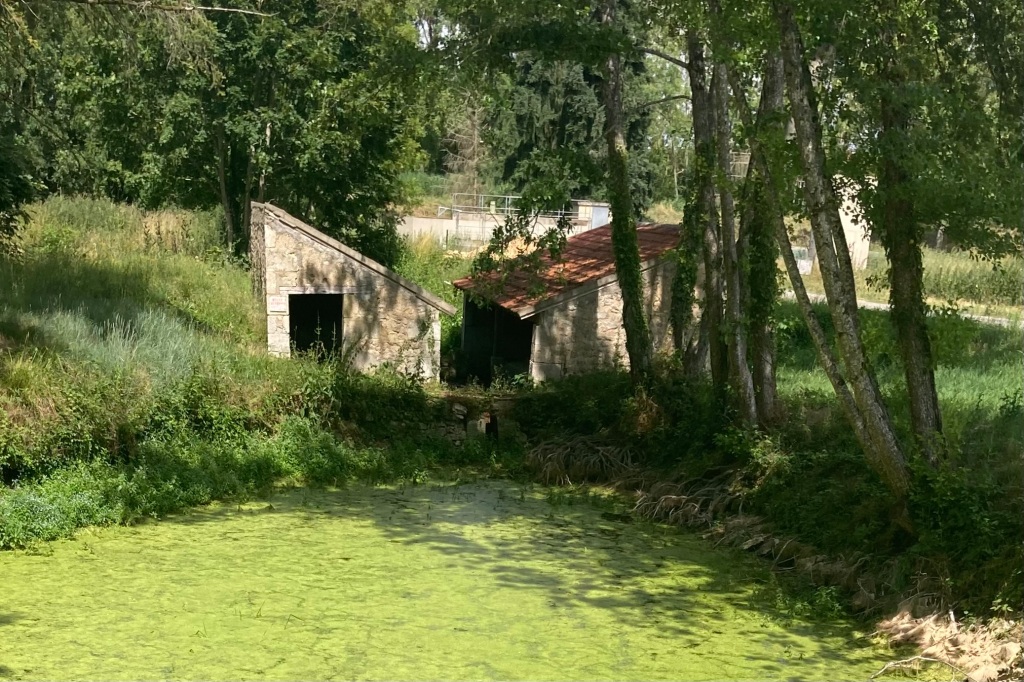

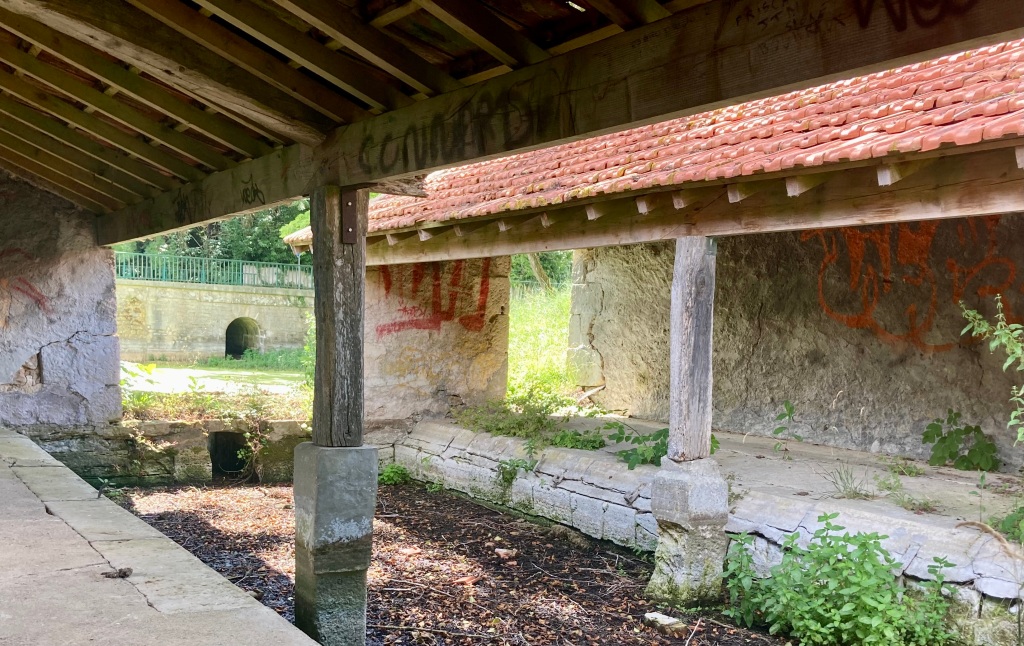
There was also the remains of an old lavoir which we spotted from the canal due to its two sloping roofs pointing down at what had been a stream. It was now a shallow pond covered in bright green algae, none of the water flowing into the lavoir itself – all a bit sad to be honest.

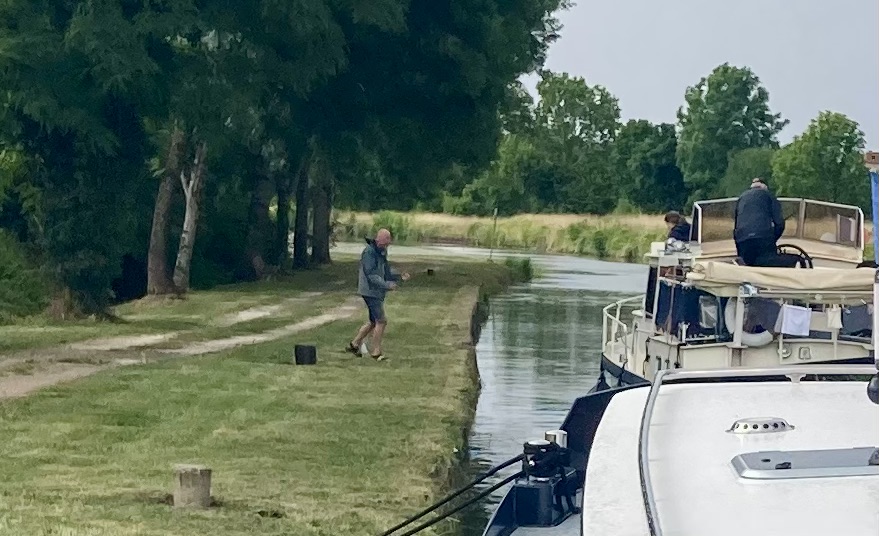
Back at the boat, we were expecting to be alone, but as evening drew in a Danish couple arrived on their boat. Stewart jumped down, in the rain, to help them. Gradually, over a succession of days and shared moorings we became friends and hope to find ourselves moored up with them again some day.
And before the day was out a phone call from Remé of Chantier Naval Ebezard announced that the battery was coming 12 hours early! He soon arrived and had it installed in no time. We were very grateful; they are heavy things to move around!

So all in all it was a happy end to an anniversary day, and with rain easing off we were treated to a rainbow as well.
On Thursday morning, bright and early (well, 9.15 to be precise) we were off to cover the 14 kms to Ménétréol-sous-Sancerre.


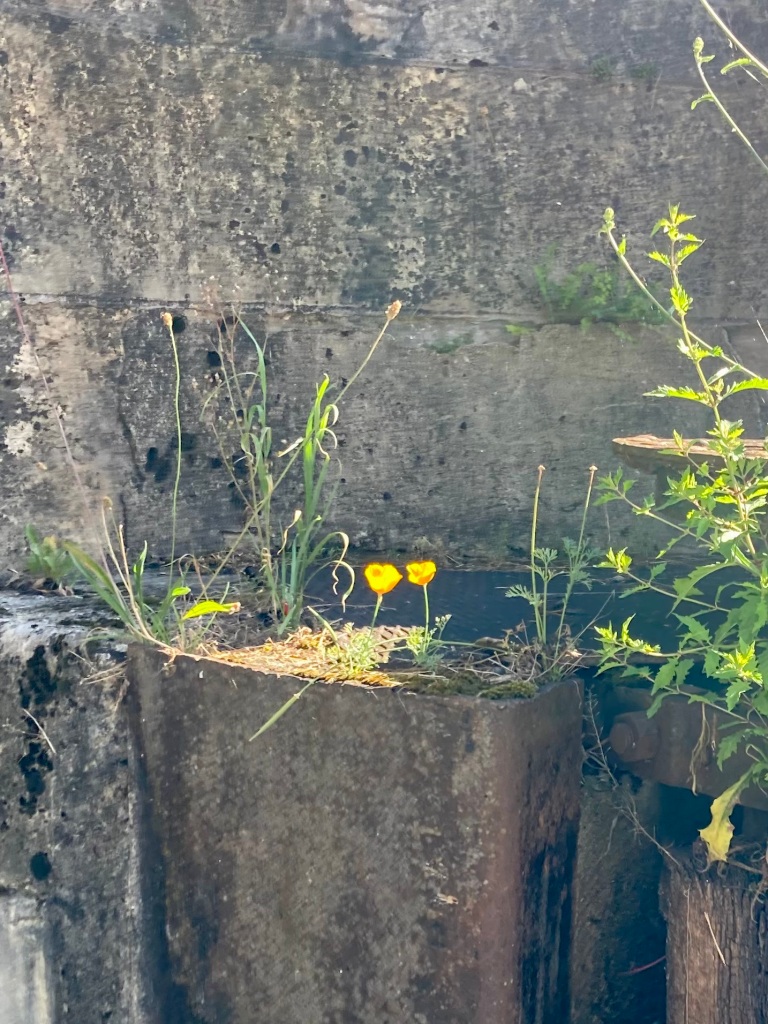
As always there were things to see along the way. Just a sample here – a night heron perched on a branch just above the water (you can just see it in the photo); a’dry’ toilet, one of a series installed at locks along the way for passing walkers and cyclists; some little golden flowers that had decided to adorn the side of a lock gate.

By now we were seeing fields of sunflowers in full bloom, splashing their sunshine colours across the landscape.
And someone has been busy along this section planting roses at each lock entrance.
So splashes of red and pink to enjoy as well as the splashes of yellow.

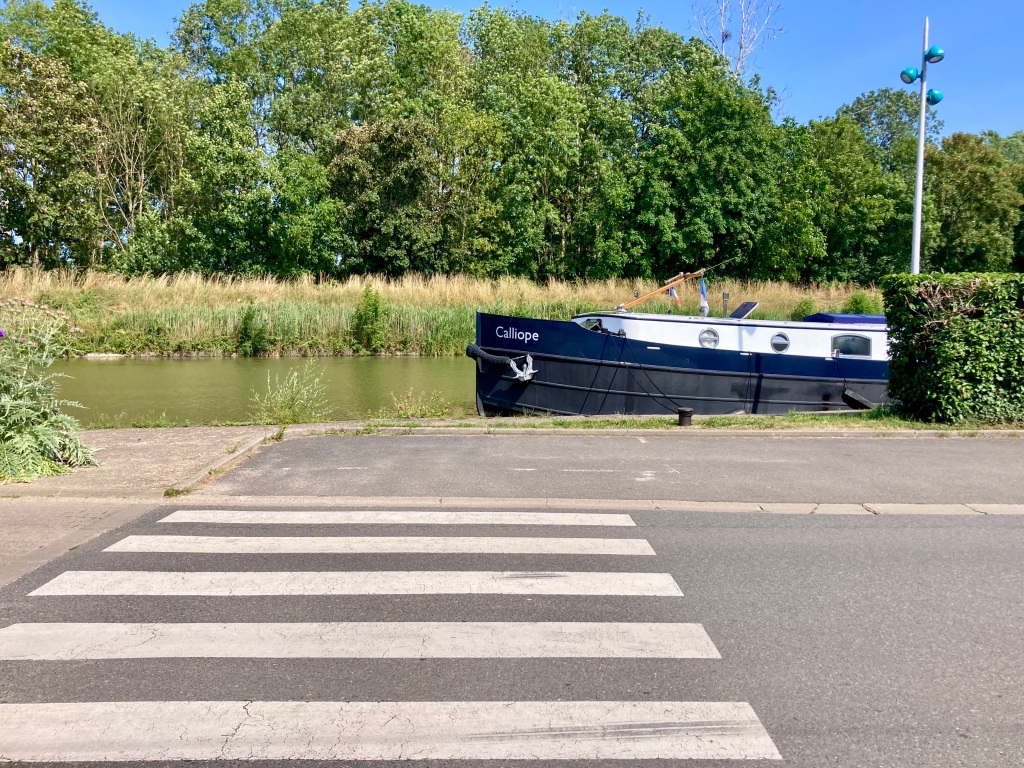
I was amused by our mooring in Ménétréol-sous-Sancerre. There we are peeking out at the zebra crossing. It was a quiet road, and a pleasant place to moor.
Ménétréol was a real surprise to us ; we found a lovely village, full of fascinating old buildings, narrow streets at odd angles, and with a huge unexpected German built viaduct marching through the centre!
And it is below Sancerre, with vineyards now covering the slopes.
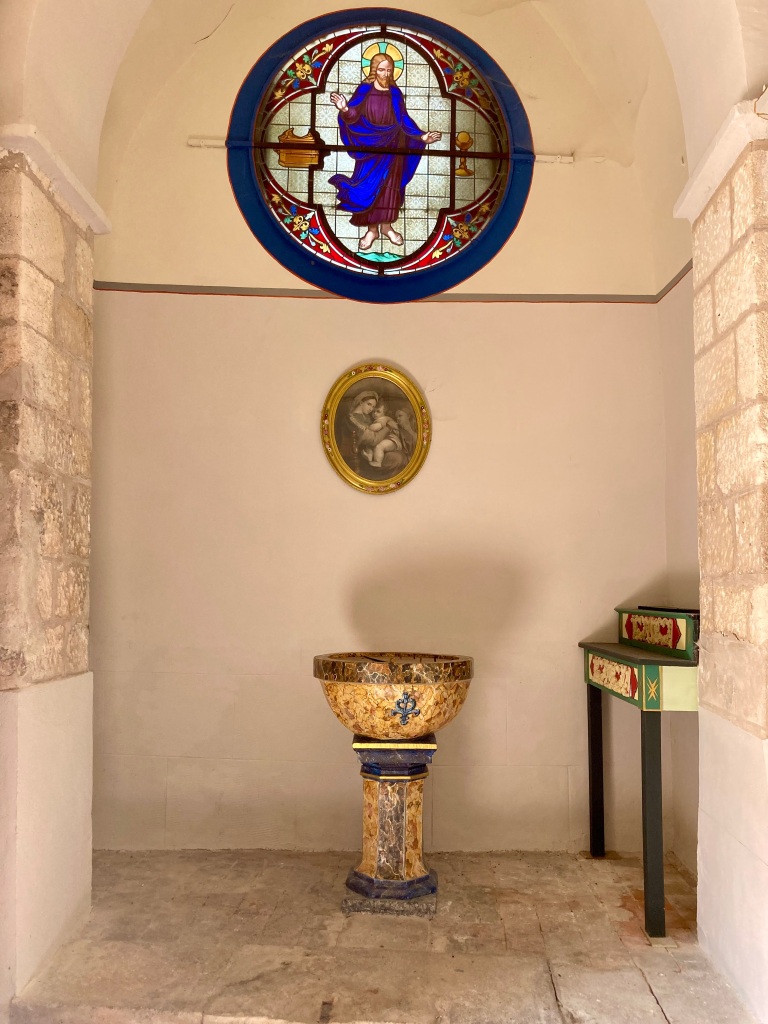

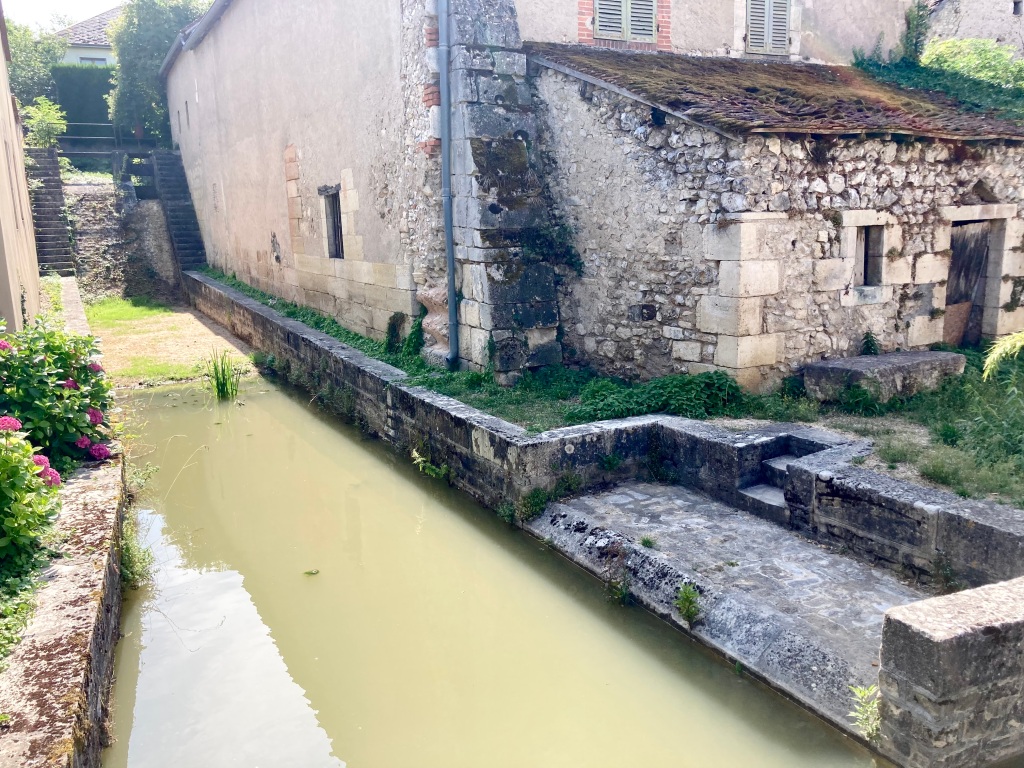
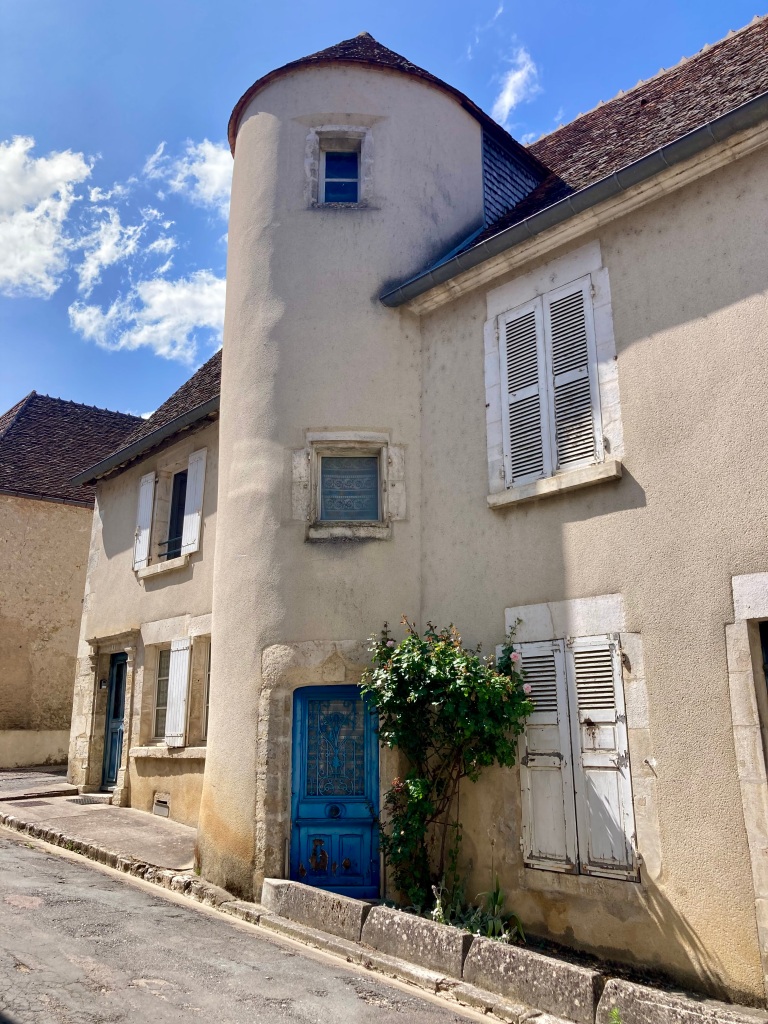
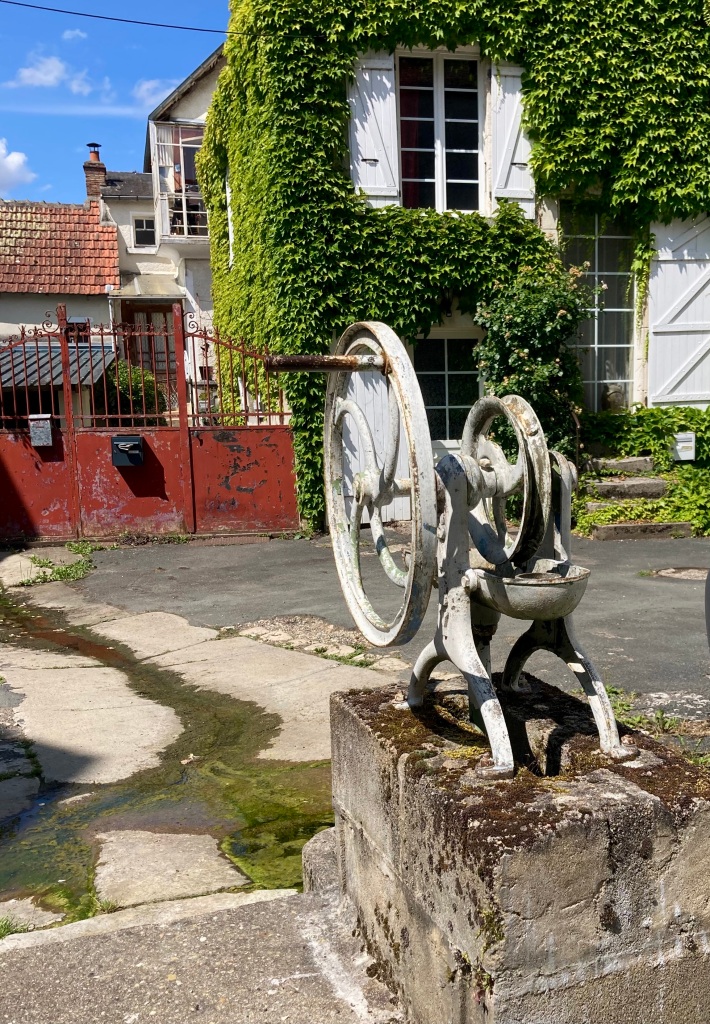

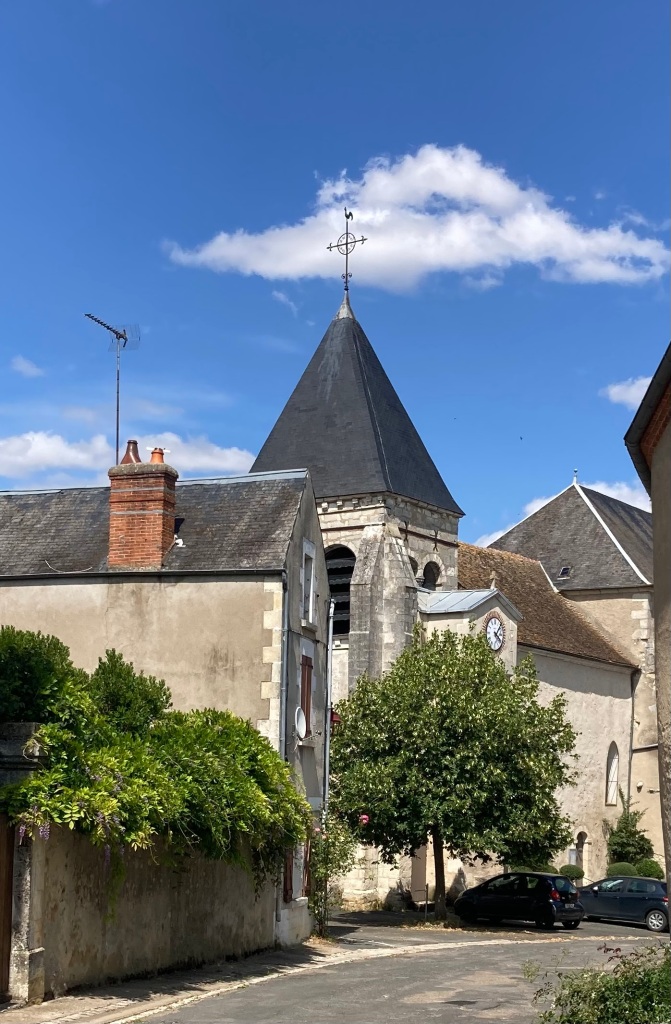

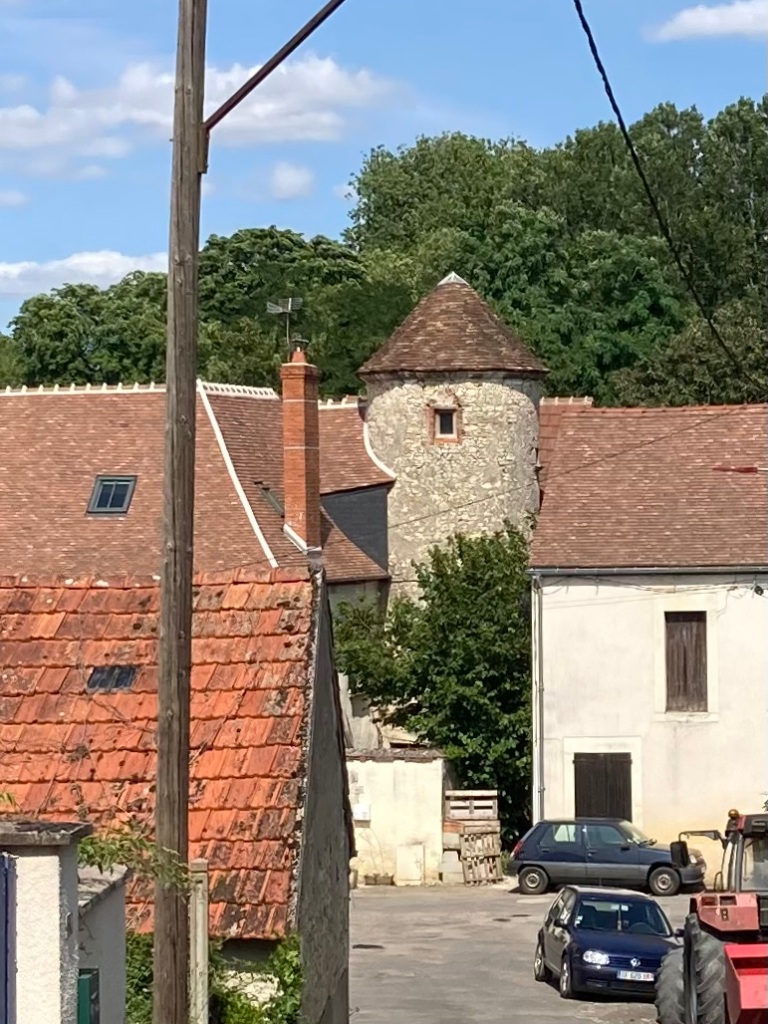
We had quite a good look round. Amongst the photo selection above are the very colourful font in the church, a simple lavoir by the old mill, a couple of methods to raise water, and quite a few views amongst the houses.
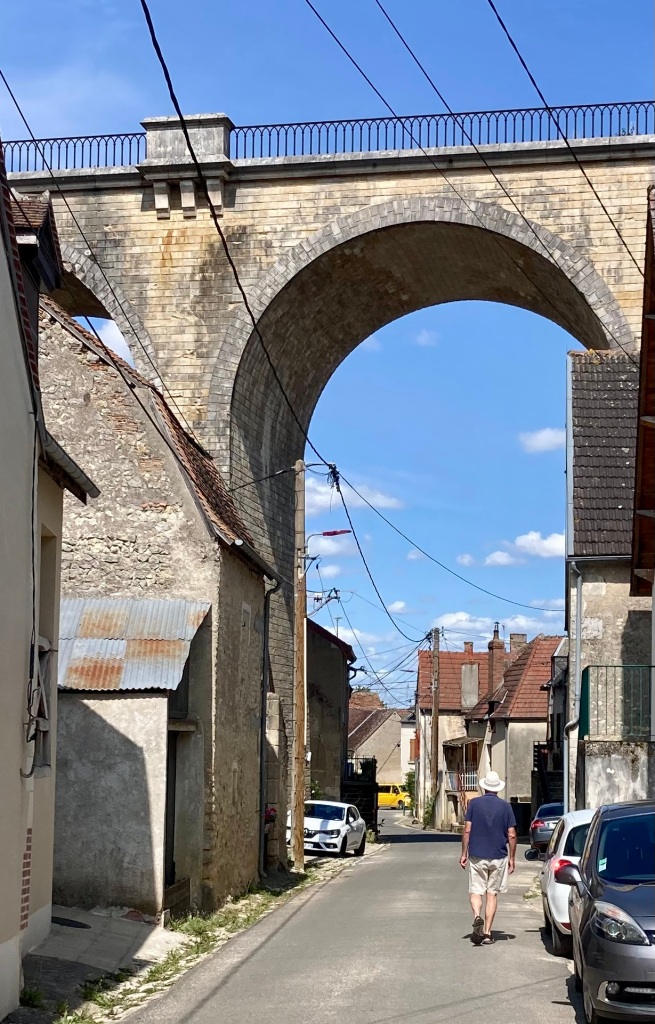
Here is the infamous viaduct, straddling roofs and streets.
Apparently it was built as part of a supply route to the front line, but never used.
It is now a walk way, with stunning views across the valley and over to Sancerre.

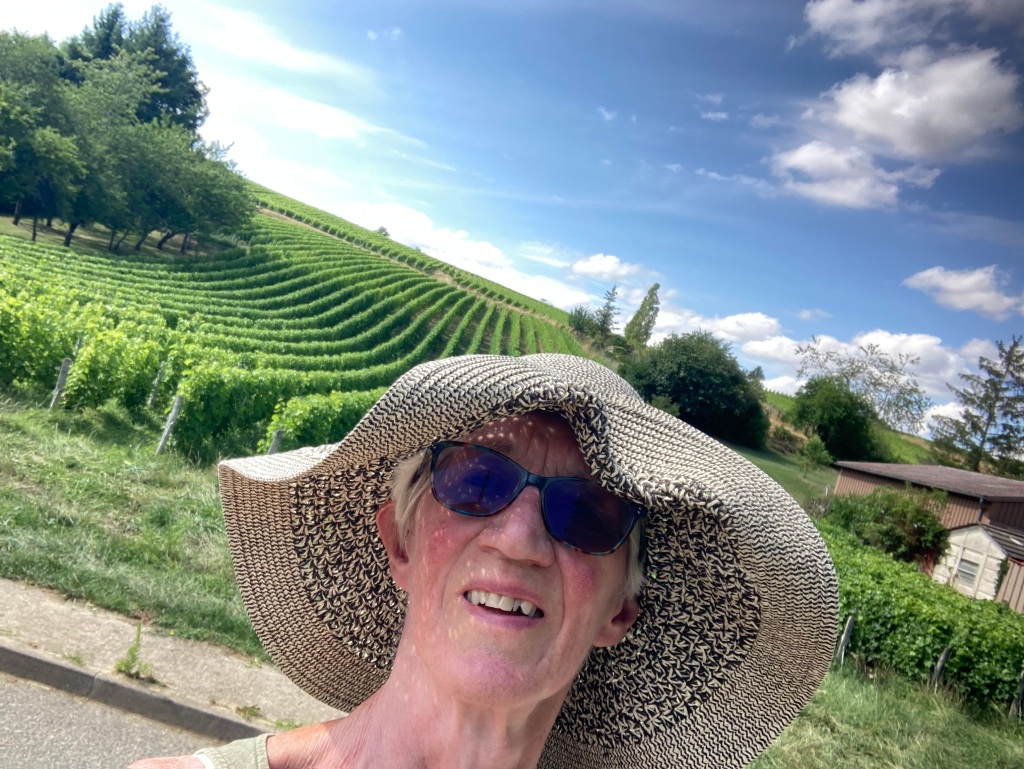
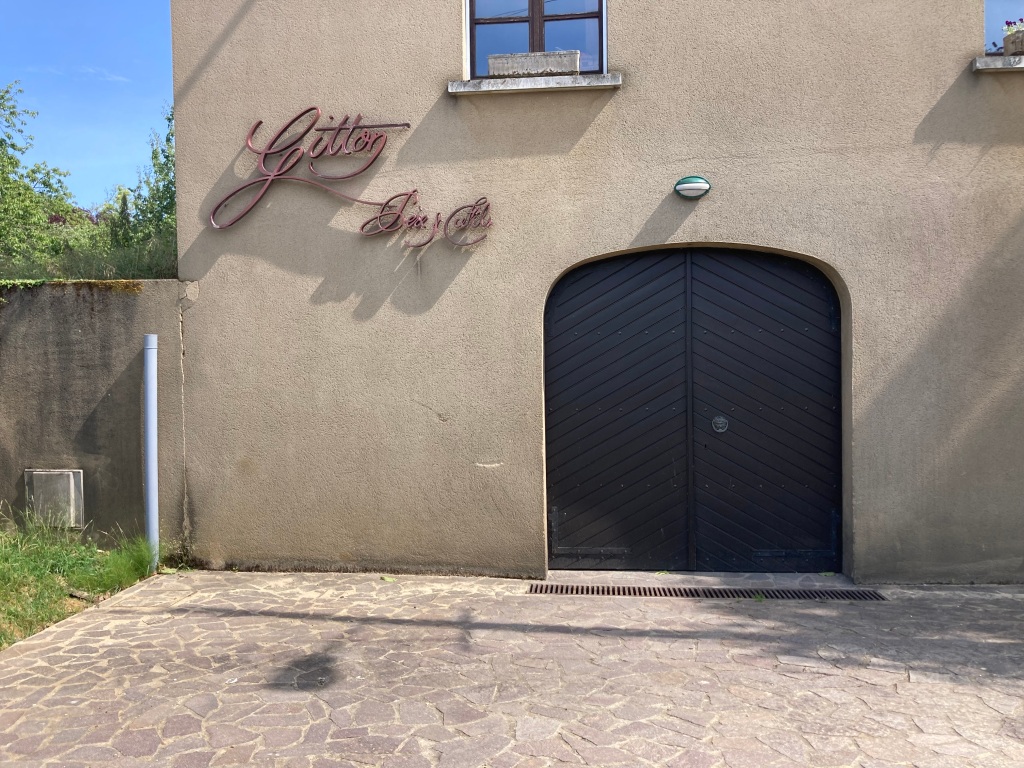
Our walk took us up above the village to a Sancerre vineyard which we were told had a shop – unfortunately closed.
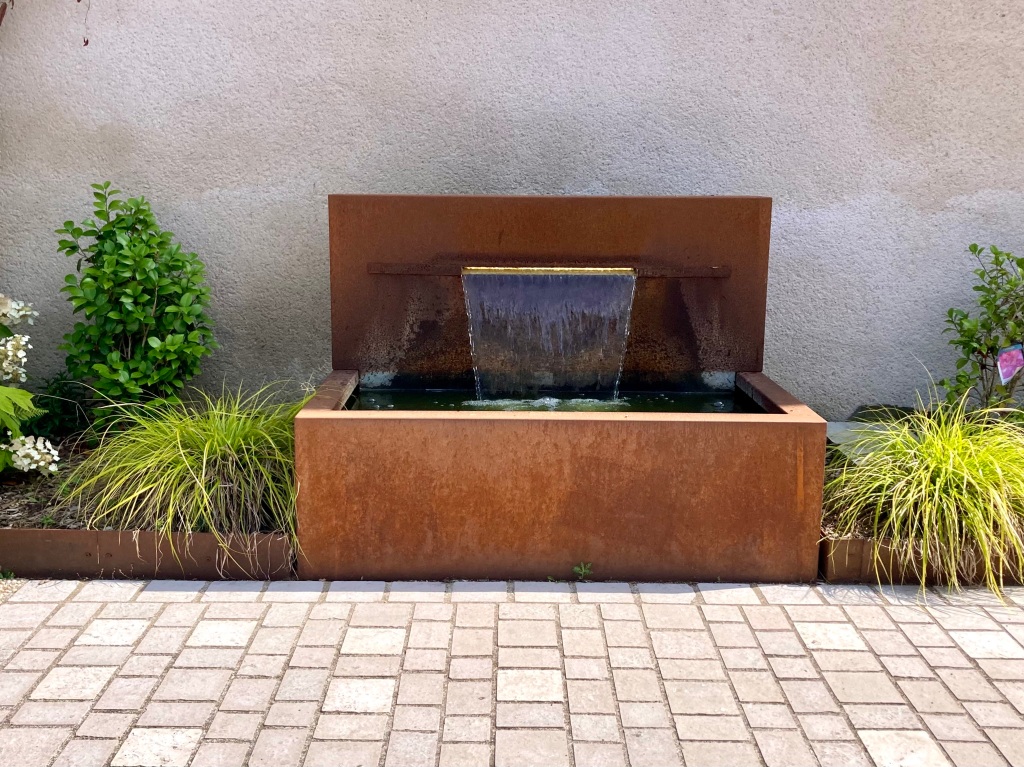
As a foil to all the antiquity there was also a very modern little square with this fountain, in memory of a man who was mayor of the village for about 40 yearts, if my memory serves me well.
It would have been easy to stay there an extra day or two, getting to know the bar and boulangerie better, as well as the buildings and the history.
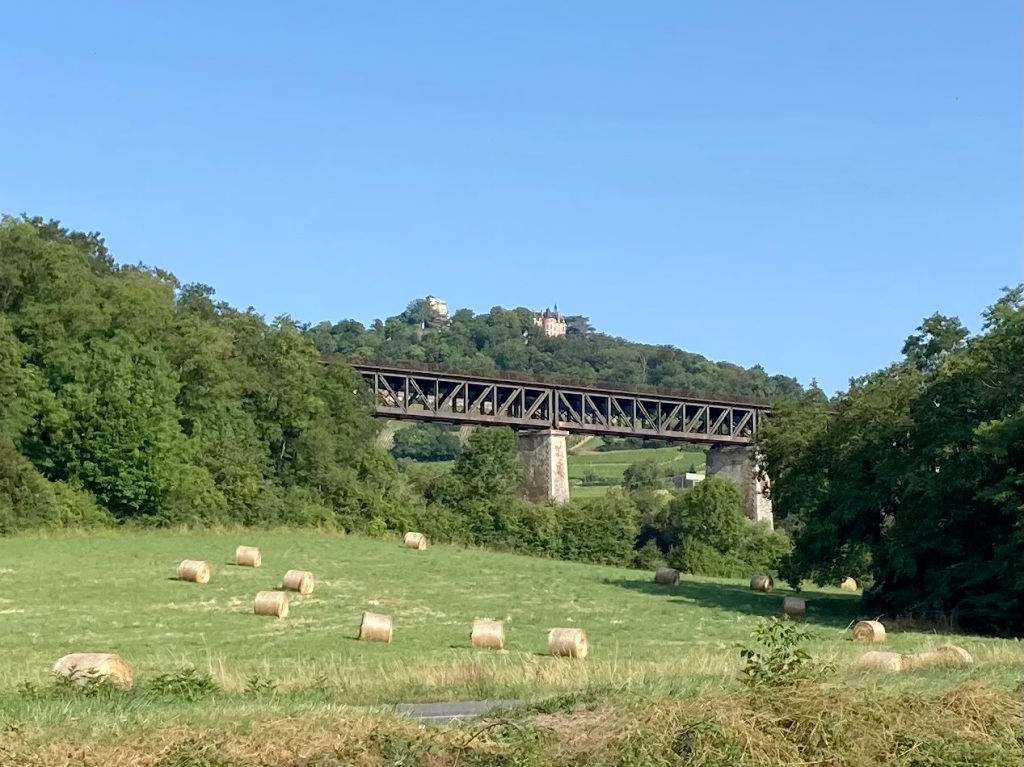
Instead we set off, leaving Sancerre village on top of the hill to our left, with part of the viaduct continuing on its route march.
We were quite keen to reach Briare, still 4 days away at our gentle slow pace, so we slipped our ropes and headed for Belleville-sur-Loire, 22 kms further downstream.

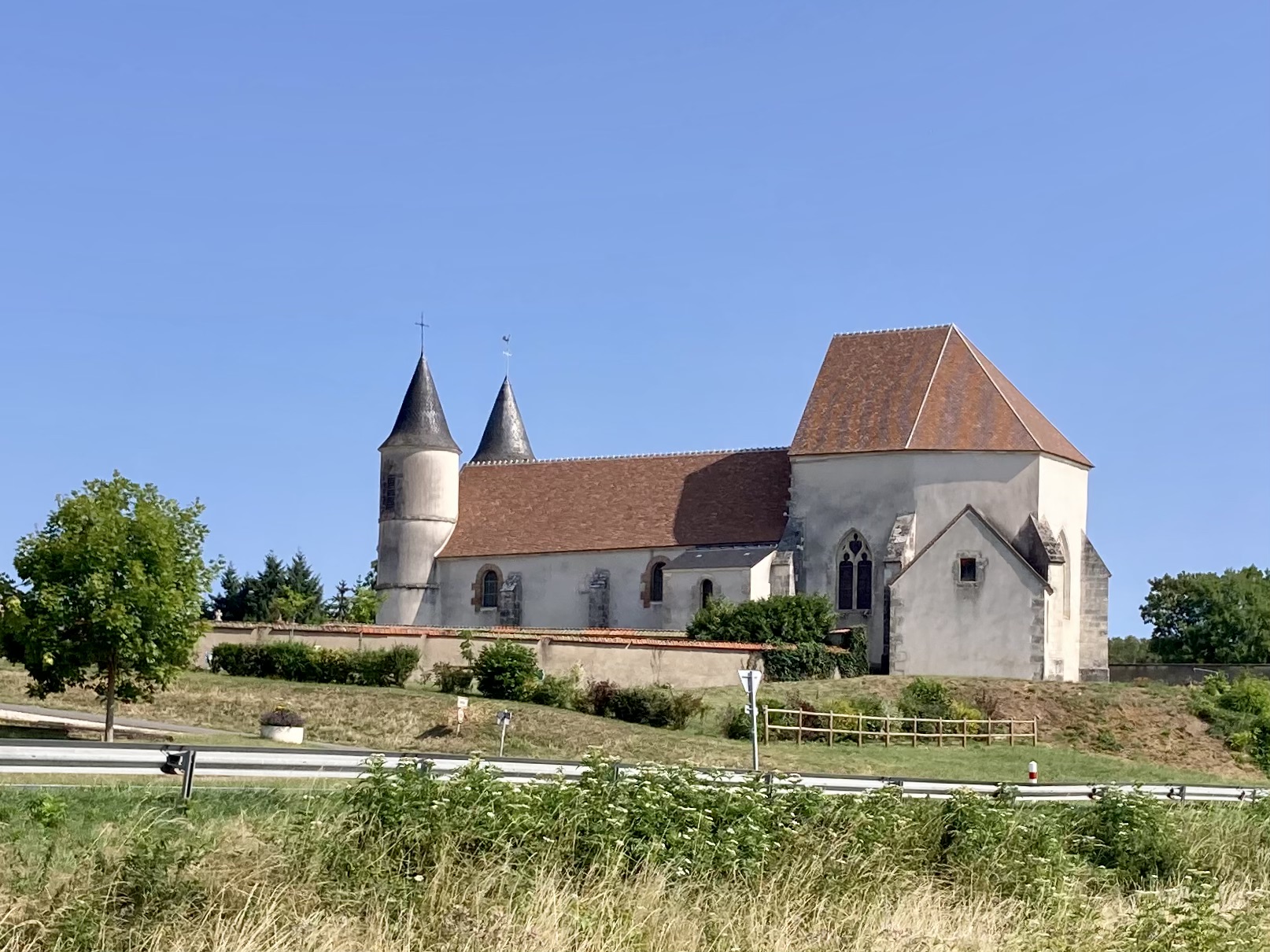
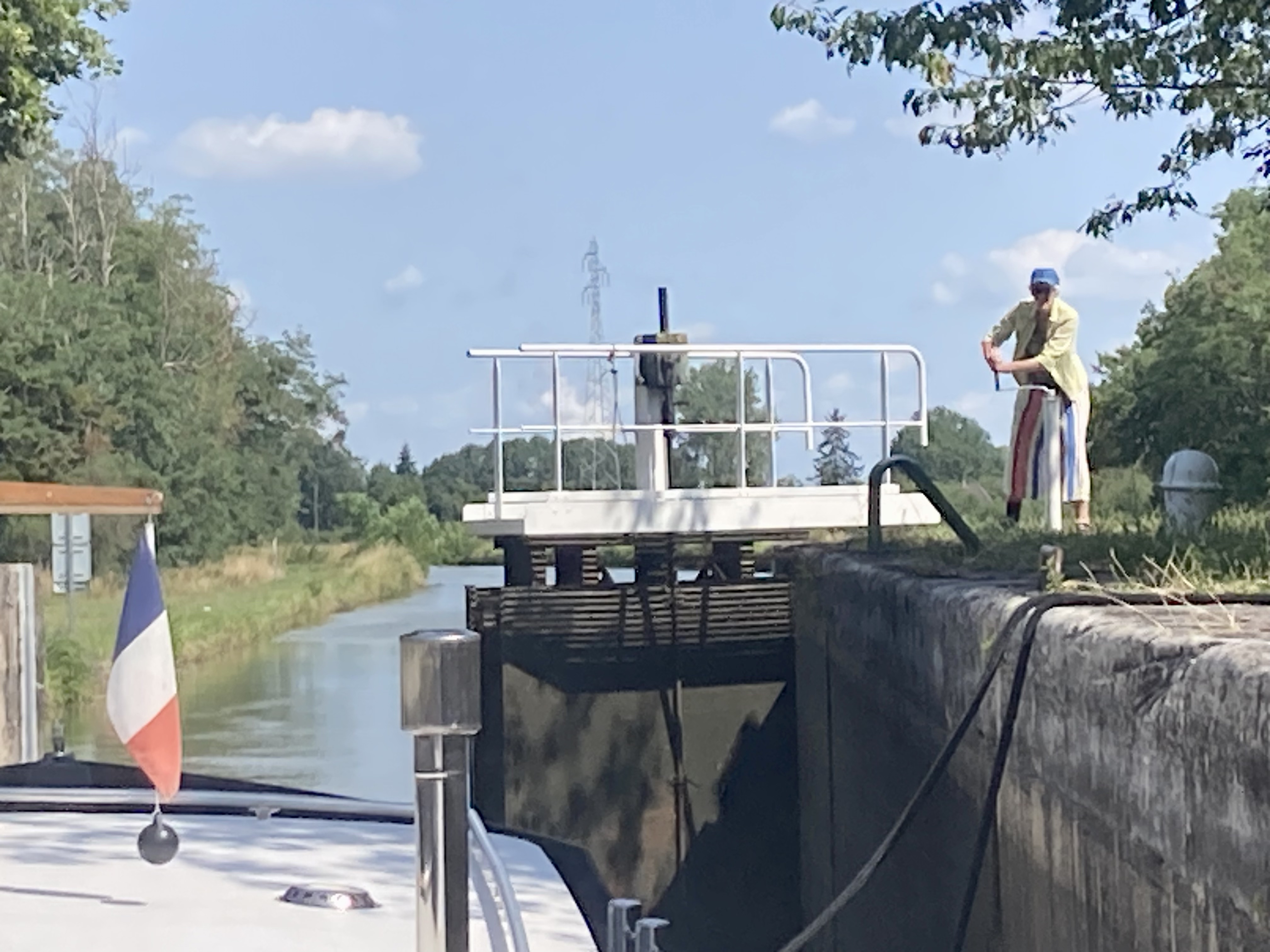
A couple of points of interest along the way – the écluse (lock) at Bannay had been a Bureau of Declaration. As far as I can make out that means it was some kind of customs post in the past, but so far my research has not told me more.
Just before the lock at Bannay we passed an old fortified church, its roof shape making its mark on the skyline.
And the next écluse saw crew (me!) jump ashore to help the éclusier open the gates. There was quite a mix of manual and automatic locks along here.
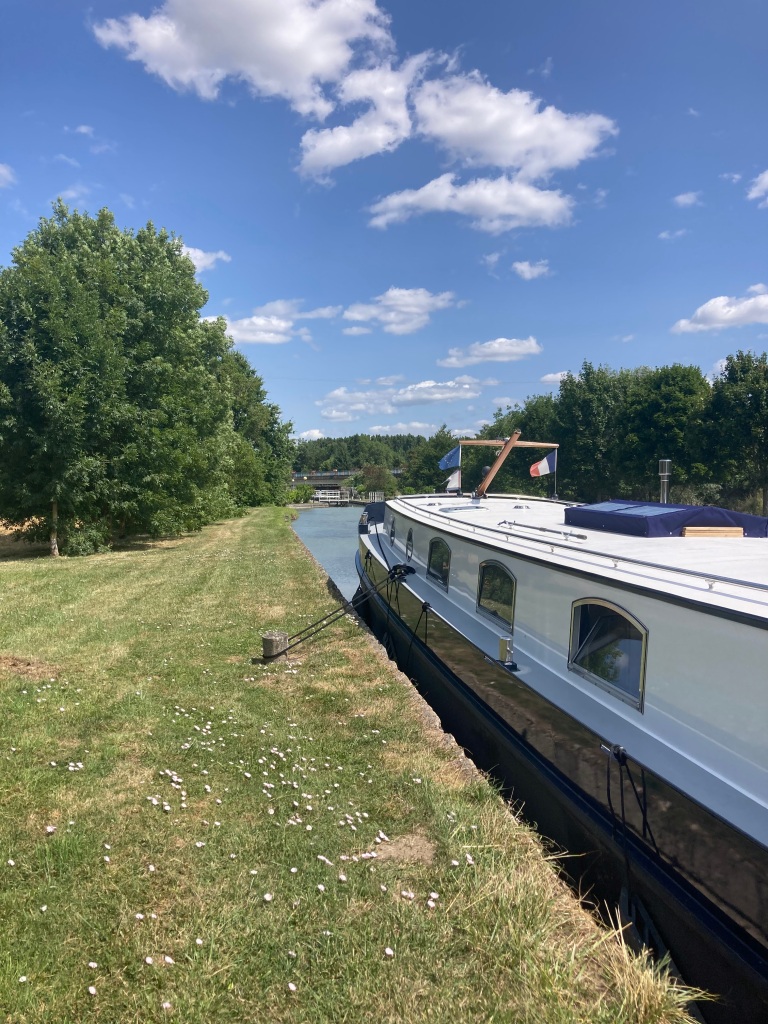
We realsied that we would not complete our journey by the noon cut off time for éclusier lunch.
The Du Breil map book showed a mooring at Léré and we arrived there just about on the dot on midday, so moored up and had our lunch too.
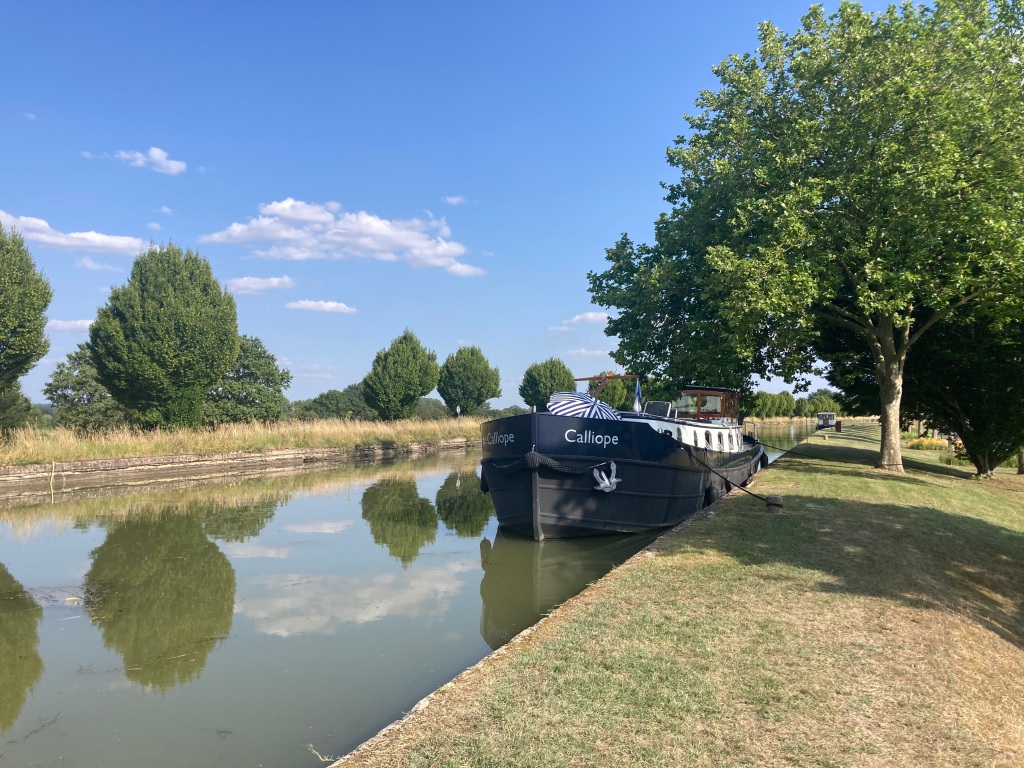
Belleville has a pleasant port below the lock, but as we were heading towards the lock and wondering if there would be spacxe for us we noticed a mooring right under a tree – in fact almost in a tree! It was a hot day and due to get hotter so this looked a perfect place to stop.
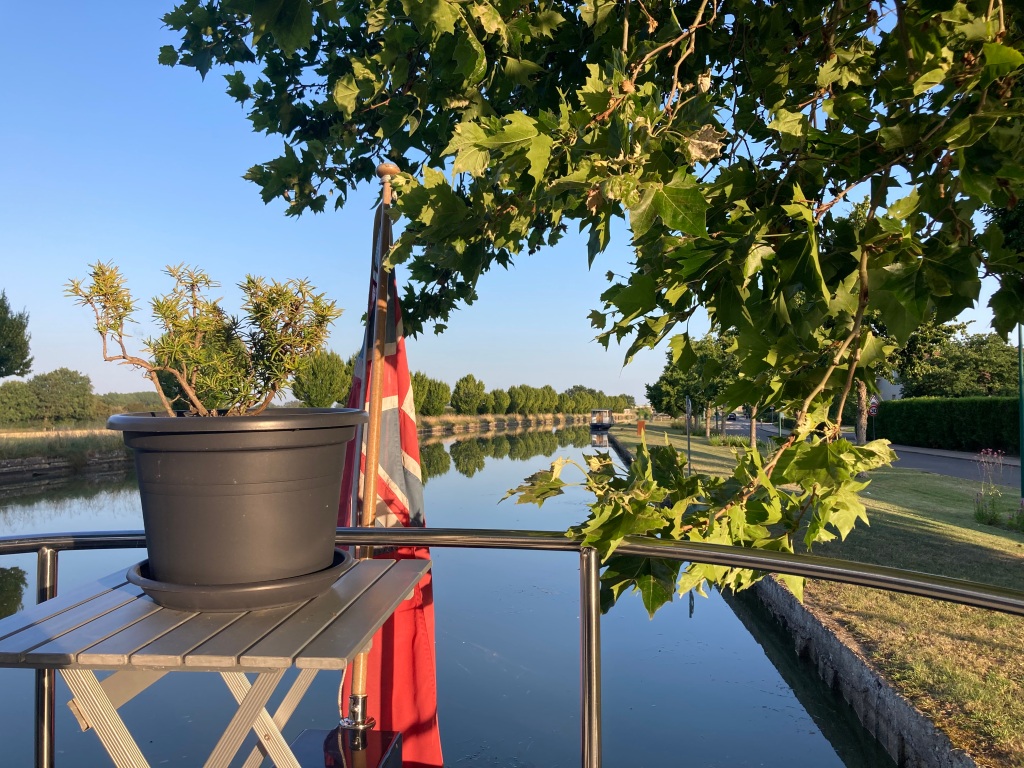
We would also be closer to the little supermarket where we planned a pick up of essentials. This was accomplished after lunch.
Then we could sit in the shade of our tree and relax.
Stewart quickly realised that this was the village we had stayed at over 10 years before when looking for a barge. Walking up towards the hotel in early evening we saw a bar with small restaurant right opposite and it called out to us with its cool beer and good menu!
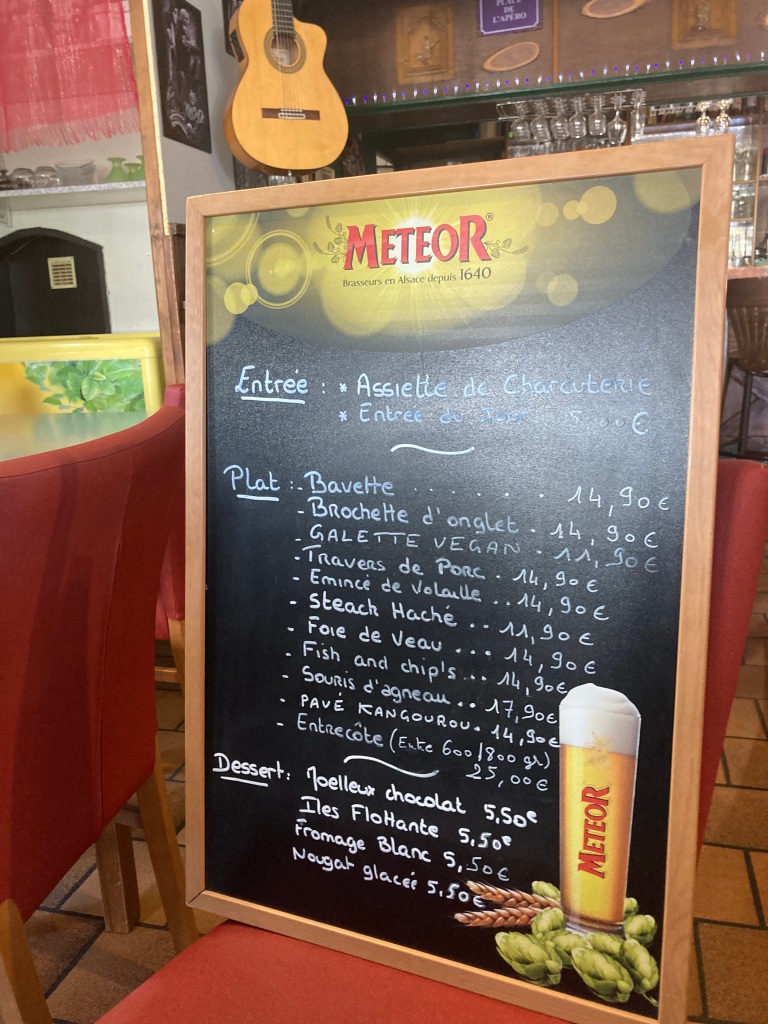
So that was supper sorted for the evening, in an interesting bar full of guitars. It turns out that the owner is/was a jazz guitarist and apparently on other evenings live music takes over.
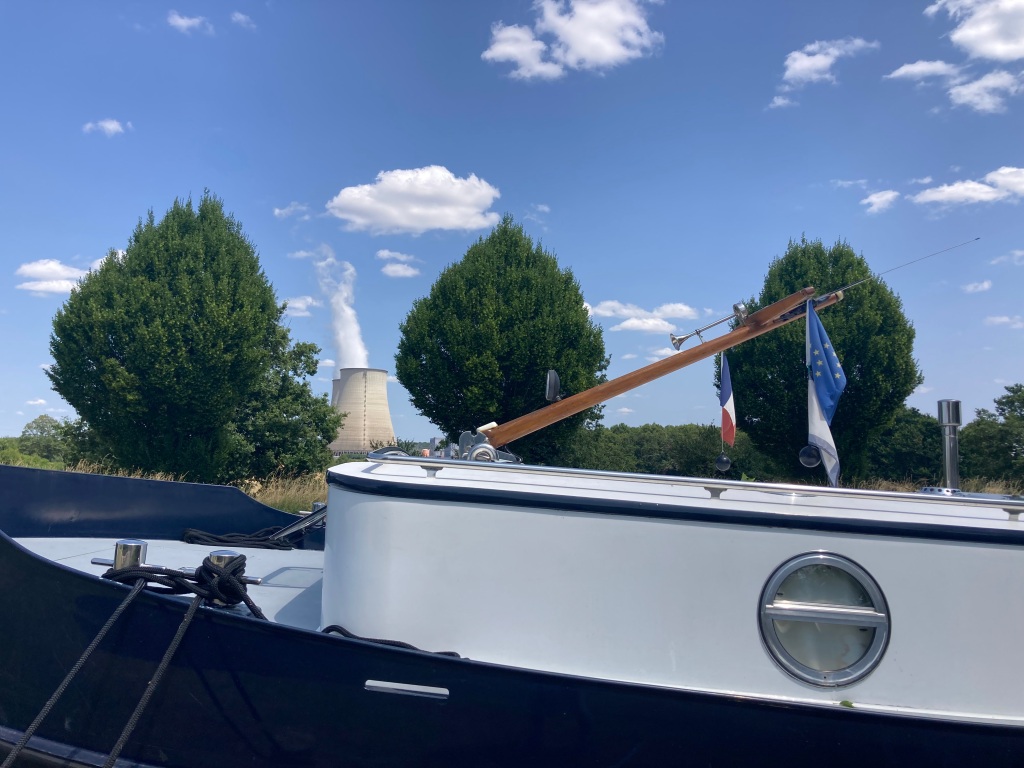
I think I should ashare with you our other view from the mooring – across to EDF’s nuclear power station !
It wasn’t unpleassant to be honest.
We had thought to stay two nights in Belleville, and I even told the bar owner ~I would be back next night for my isle flottant dessert, having been too full for one the previous evening.
But a mix of being a bit too caught up in the tree at our Belleville mooring, and thinking that the port below the lock was full, we decided to go a full 4kms (!) on to Beaulieu.

The morning brought a very different colour sky, a great dark canvas for the power station steam. I love the cows grazing unconcerned below.
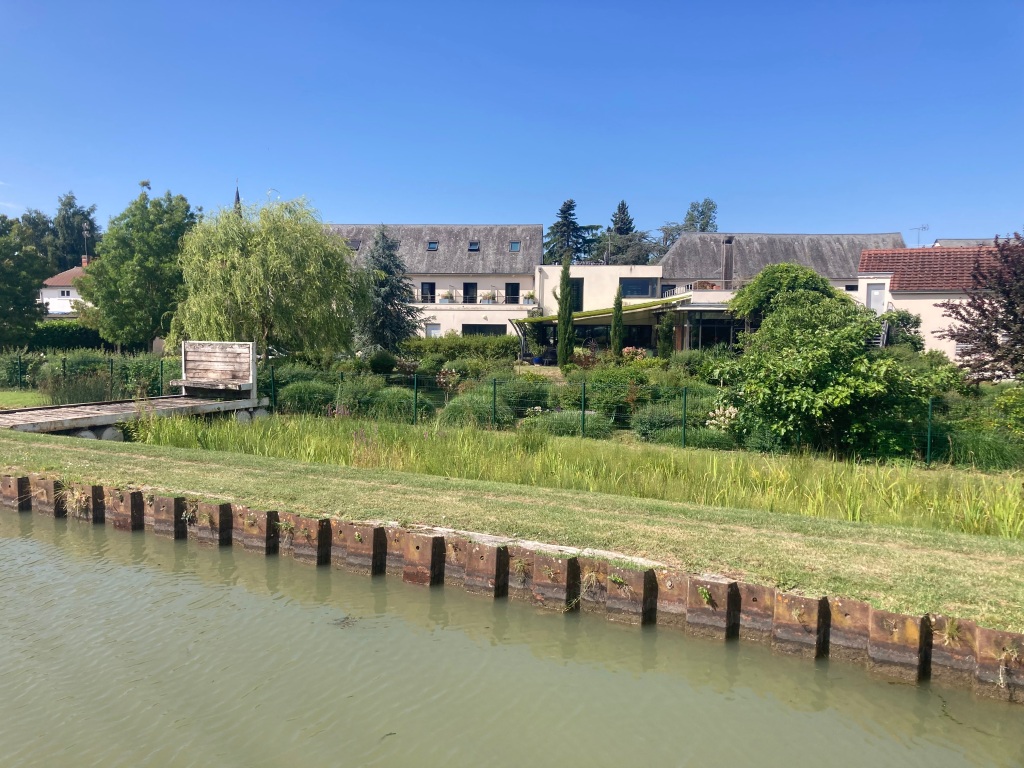
Then as we left town we passed the hotel I mentioned earlier – part of our odyssey to find a barge, and now here we are 10 years on cruising past!
The skies ahead were blue, and once more we enjoyed the flowering efforts of people who have gone before us, planting such colour by bridges and locks.
And we were lucky to be there at the best tine if year by the look of it.

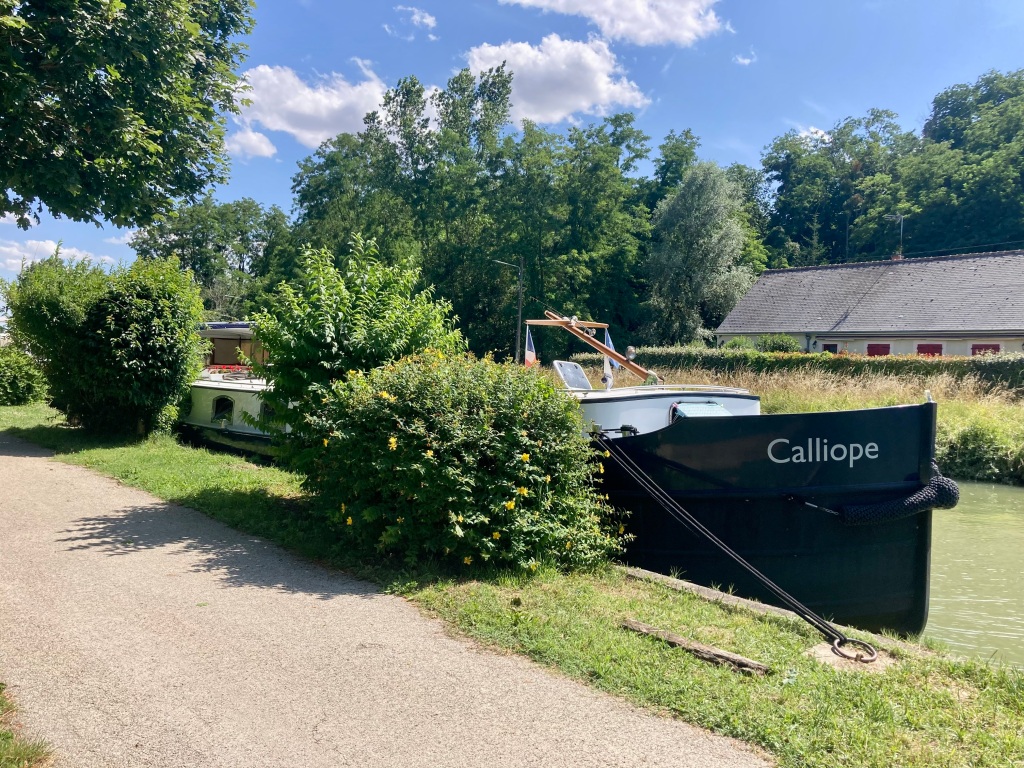
It was a good decision to move on. We found ourselves on another green mooring, below the village of Beaulieu , which is up on a hill. I walked up (it was rather hot) to find us some bread for lunch.
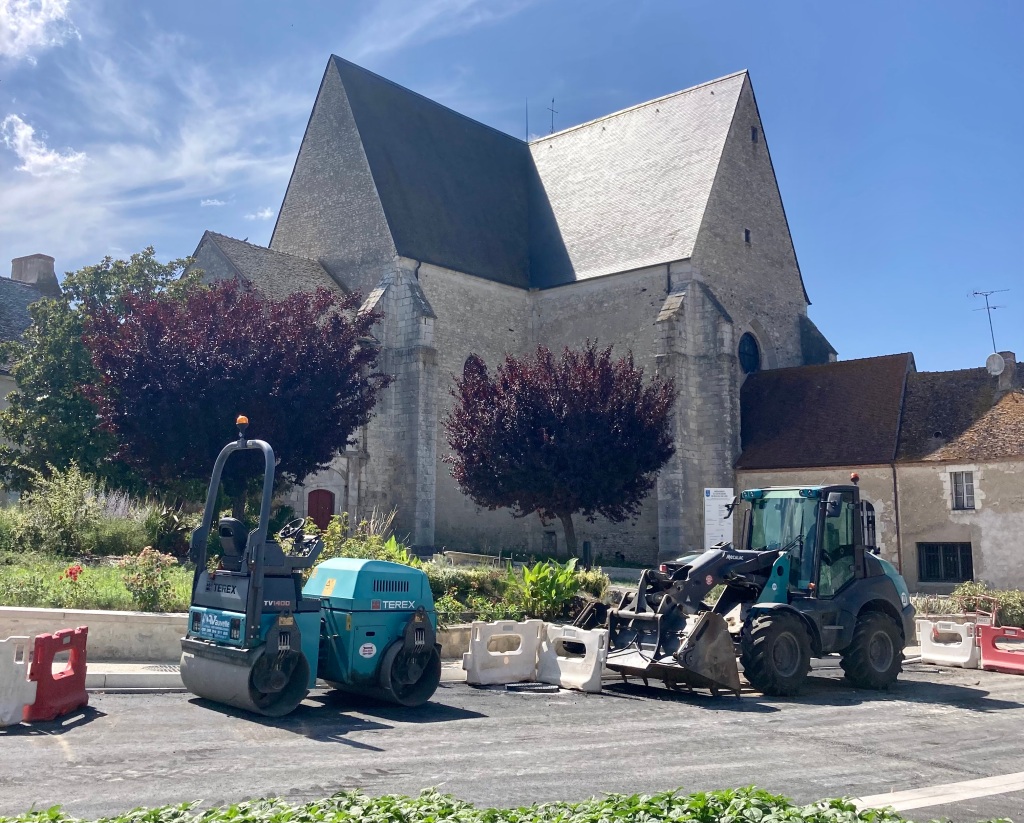
I did find bread, and in addition I found a village turned upside down with the entire centre being re-surfaced.
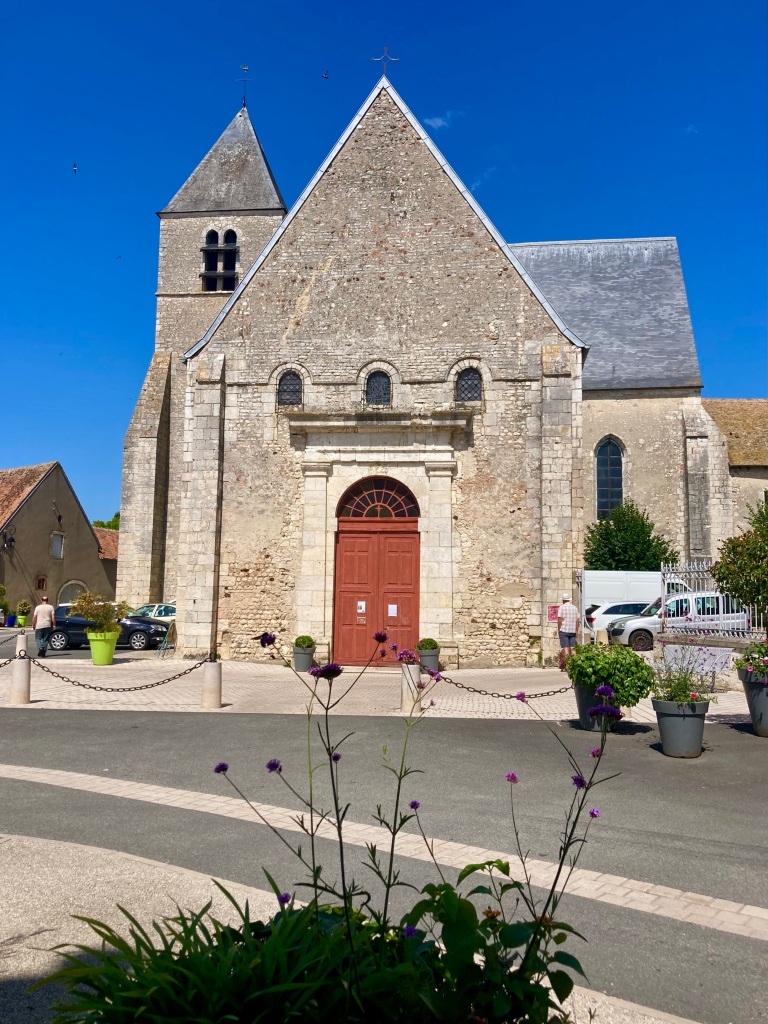
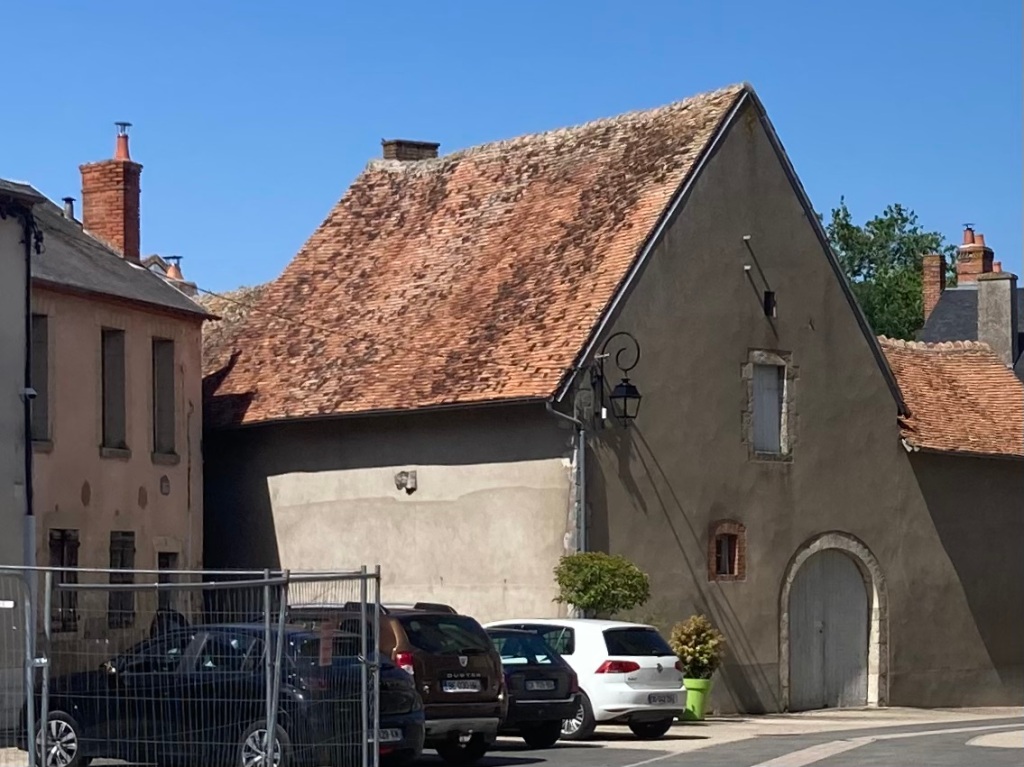
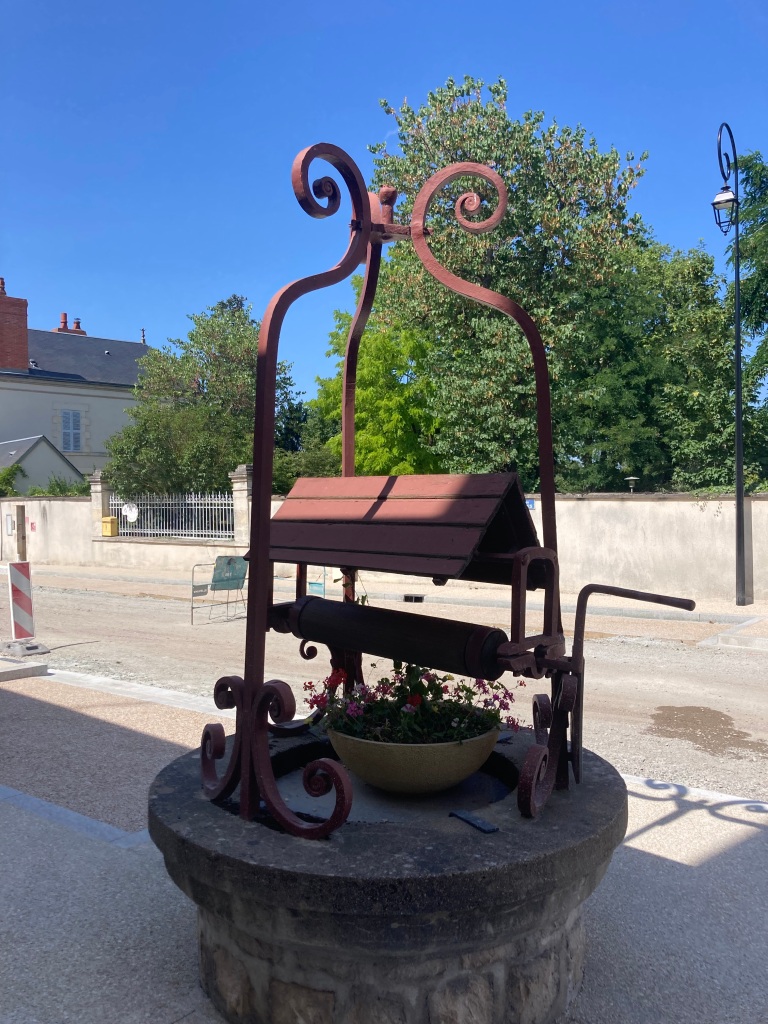
Despite the road works it was possible to admire the church and a few other old houses.
Later. after Stu and I had walked back up in the afternoon, we found back at canal level the ‘fountain’ where villagers could come and collect water.
On that hot day ot was a very welcome cool green oasis.
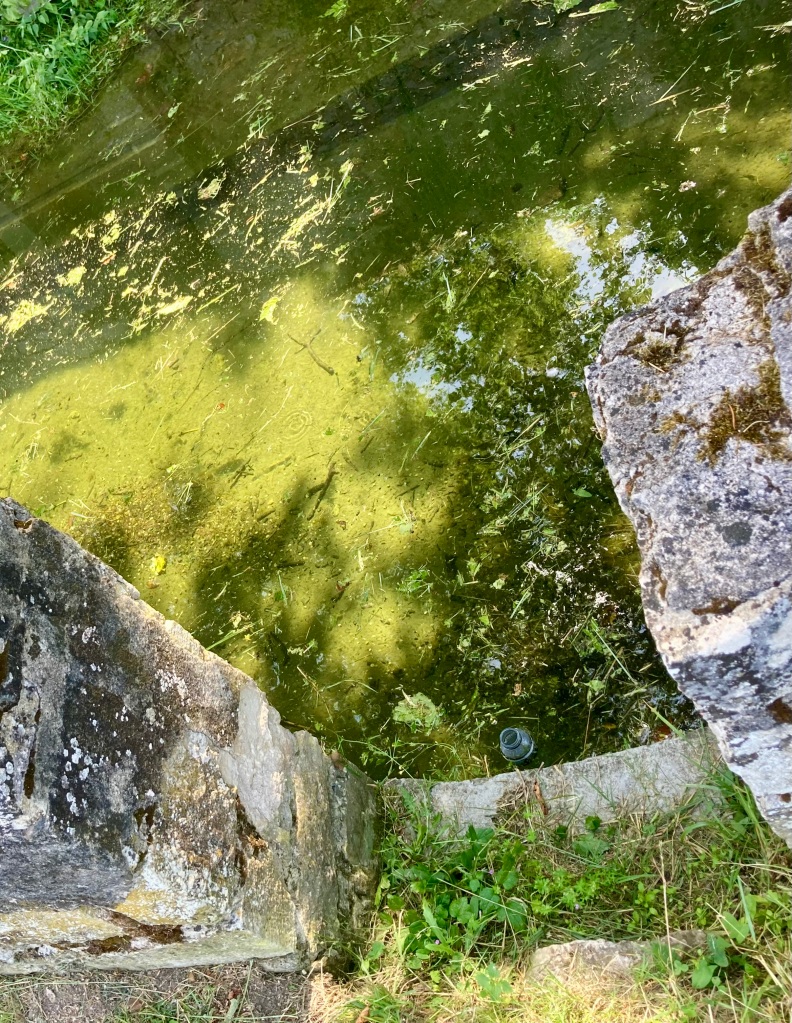
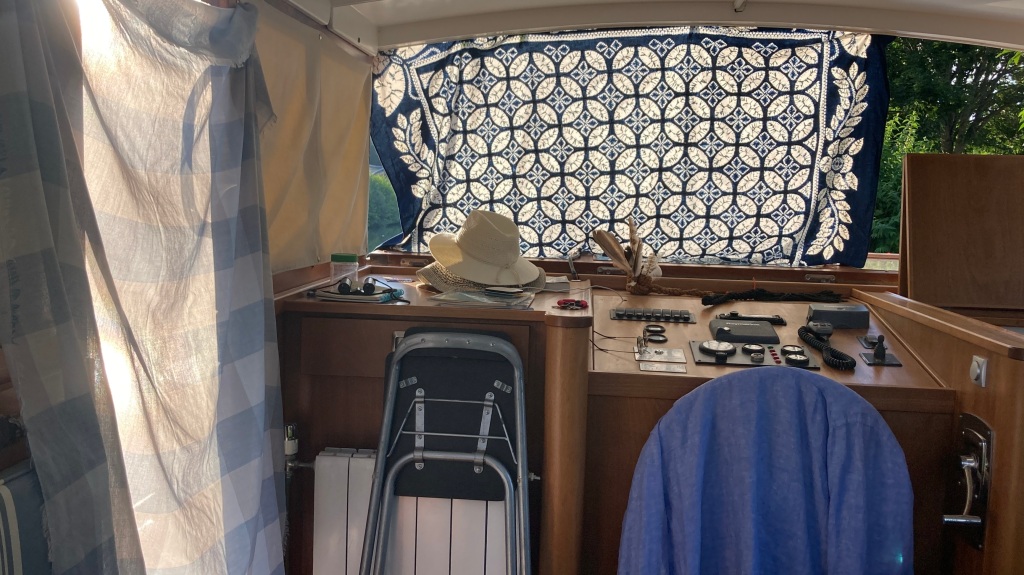
It was one of those 32C+ days, when we make the wheelhouse super shady – parasol on the back deck, and various ‘drapes’ that will move in the breeze, whilst keeping the sun firmly out!
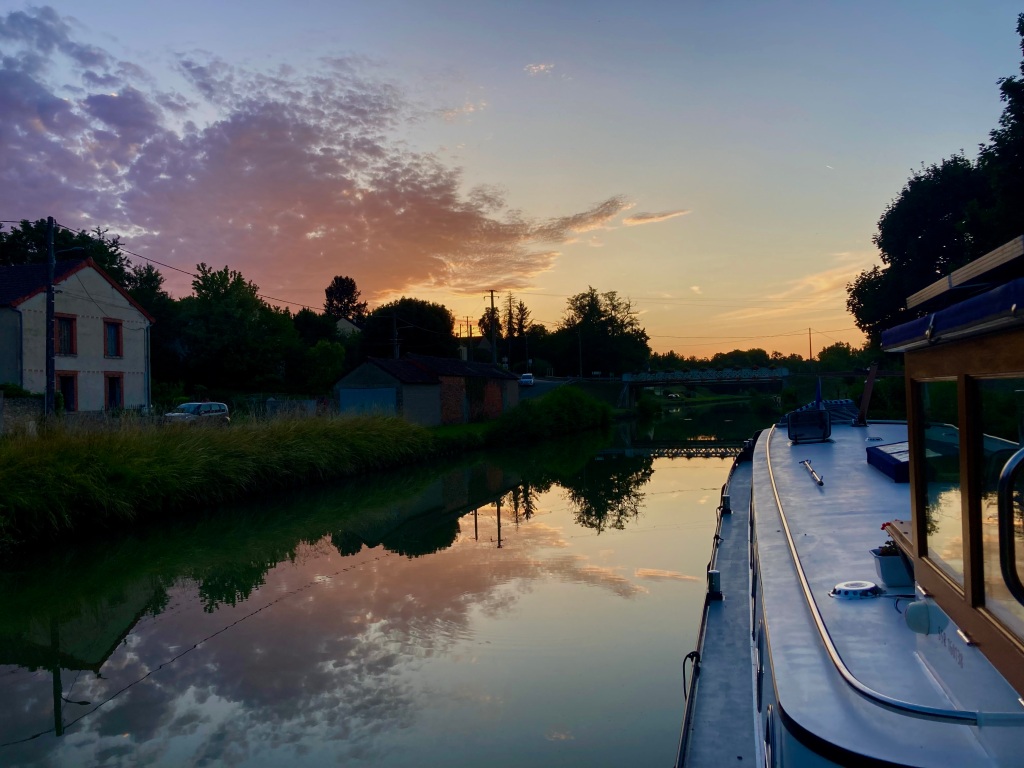
And as the sun went down and the evening temperatures took over, we were treated to another peaceful pink sky.
And then we had just one more stop on the Canal Latèral à la Loire before we reached Briare and the end of this particular stage of our 2023 journey.

Before we left Beaulieu I used the dew on the roof and the lower temperatiures of the morning to give the roof a quick clean.
Then, as we set off, I sat out in the shade of the port side of the wheelhouse, enjoying the fresh air and scenery as we motored along.
Our last stop was to be at Chatillon-sur-Loire . To get there we passed a historic junction, where the original lateral canal went down towards the river. It is now called the Embranchement de Chatillon and runs alongside the current canal.

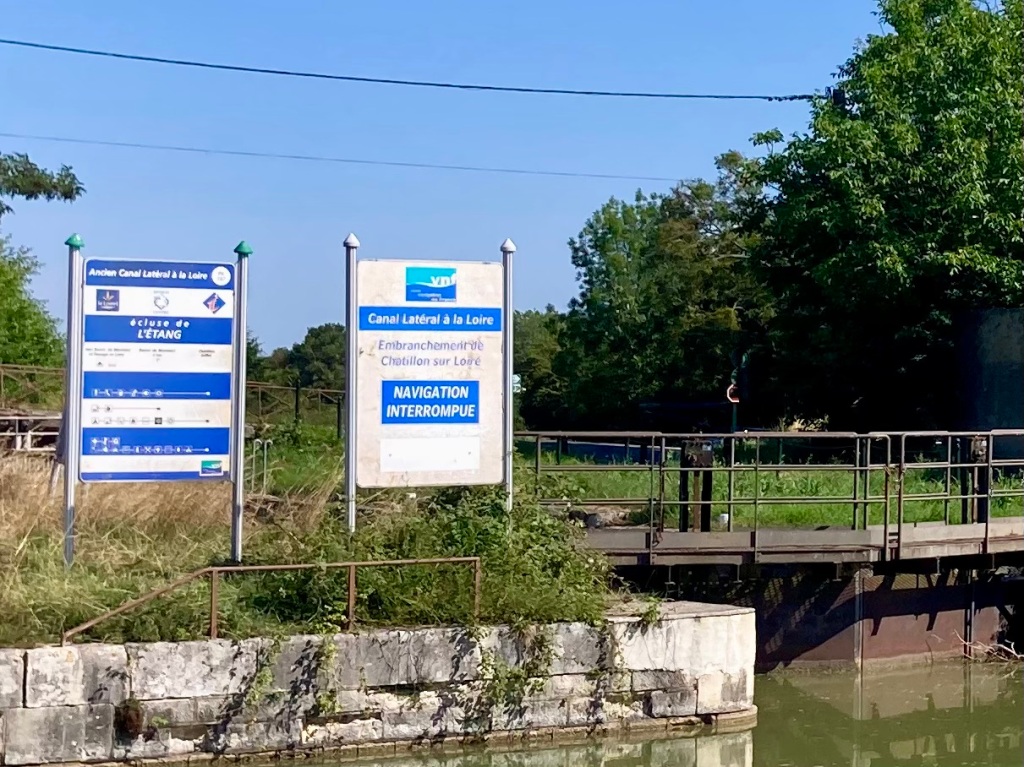
This was the route that barges had to take, then cross the river and rejoin the canal on the other side. This was before the mammoth Briare aqueduct was built – more of that later.
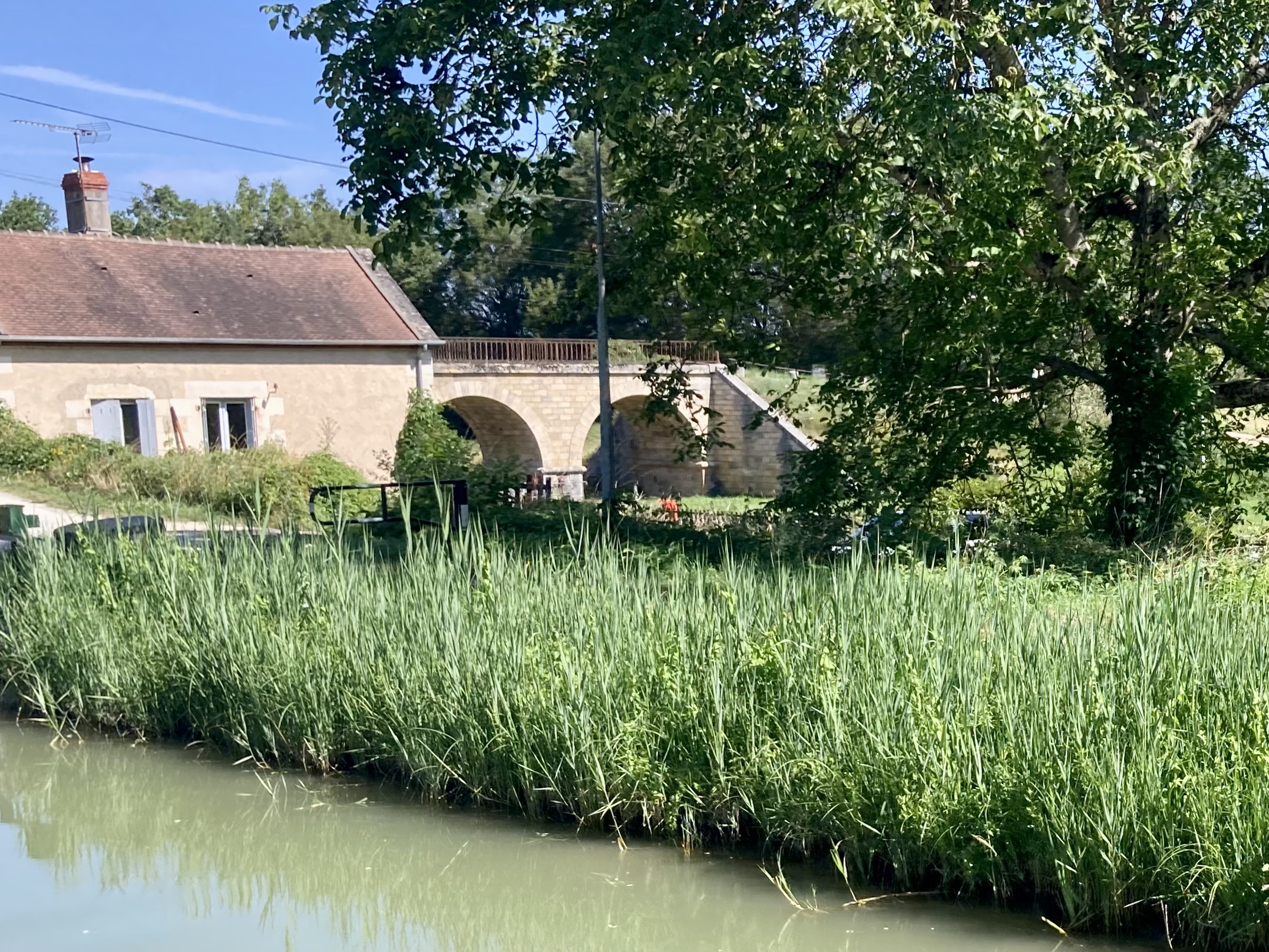
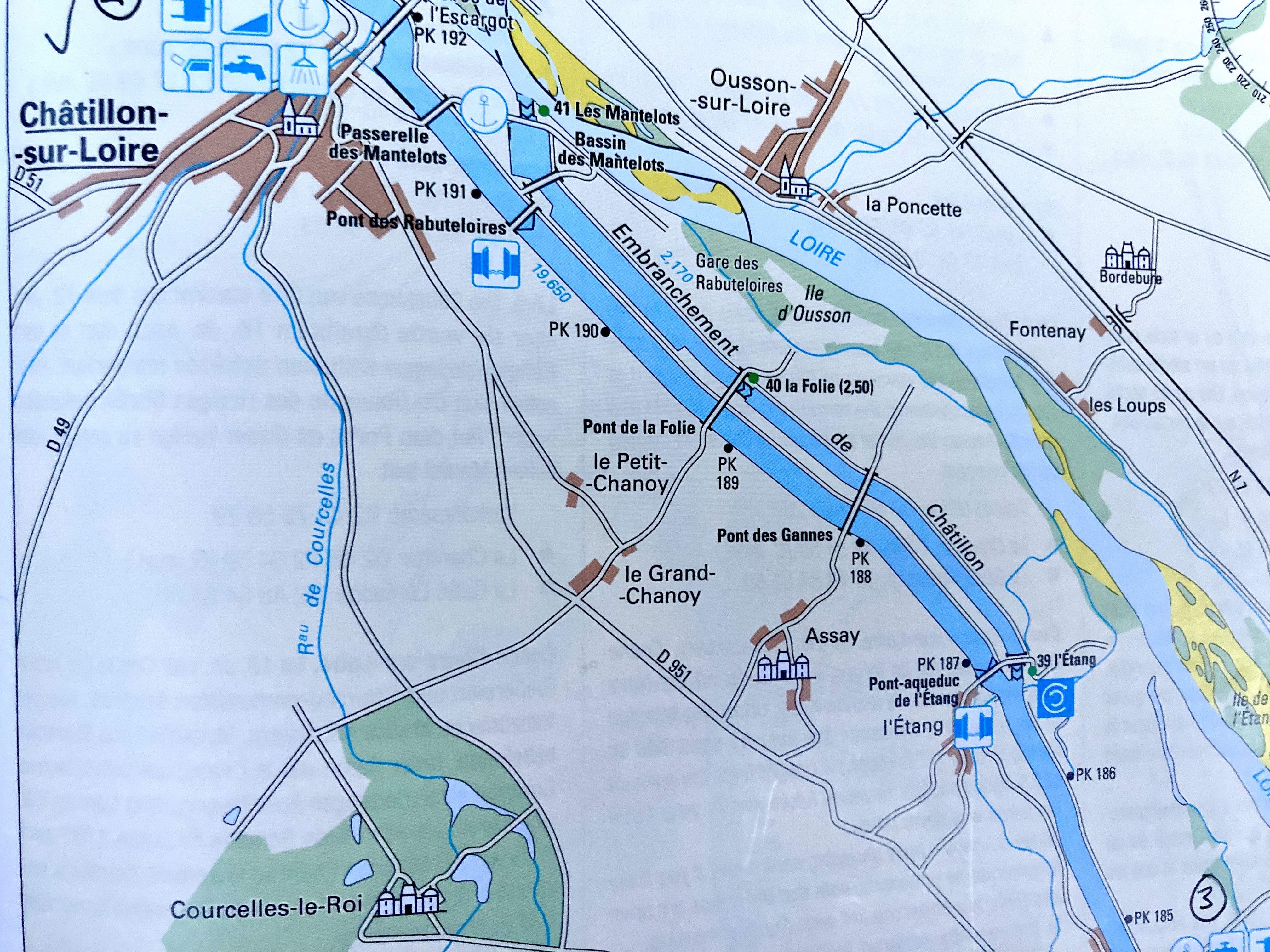
Occasionally we could see the old canal next to us, in this photo passing under a bridge. The map shows their relationship to each other, and also the nearby river Loire itself.
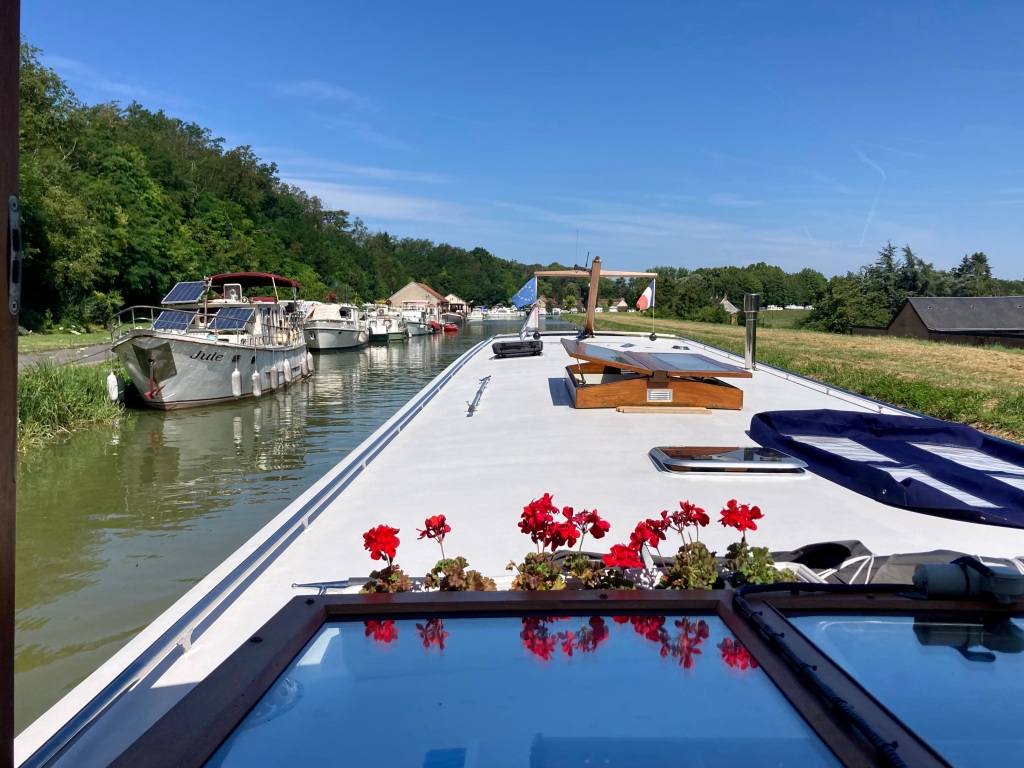
We came into the port at Chatillon wondering if we would find a place to moor. We did, although it was in full sun on what turned out to be rather a hot day. Never mind; we know how to manage that! We could plug into shore power and turn on the AC in the cabin before we went to bed, and during the day, find shady breezy spots on and off the boat.
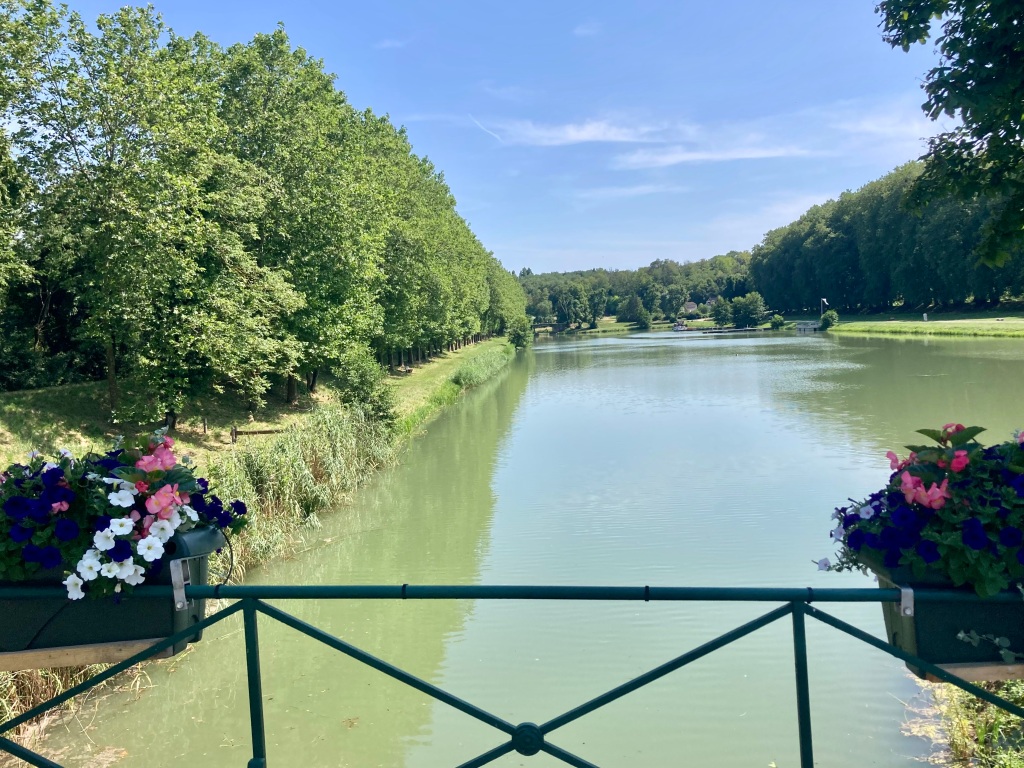

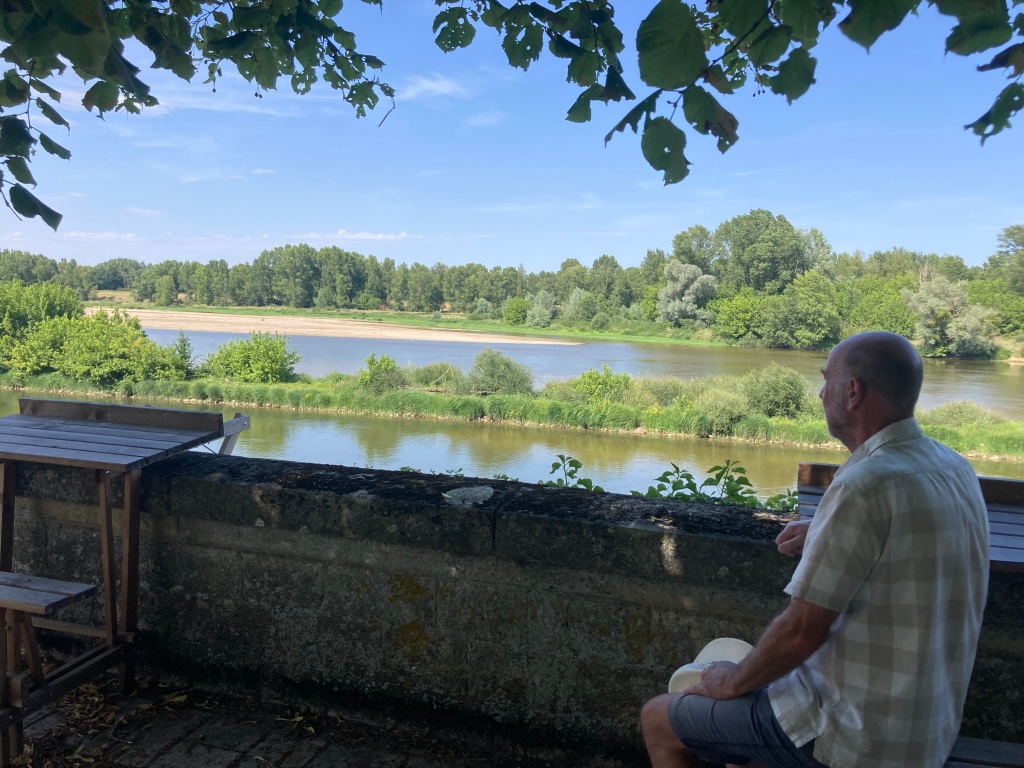
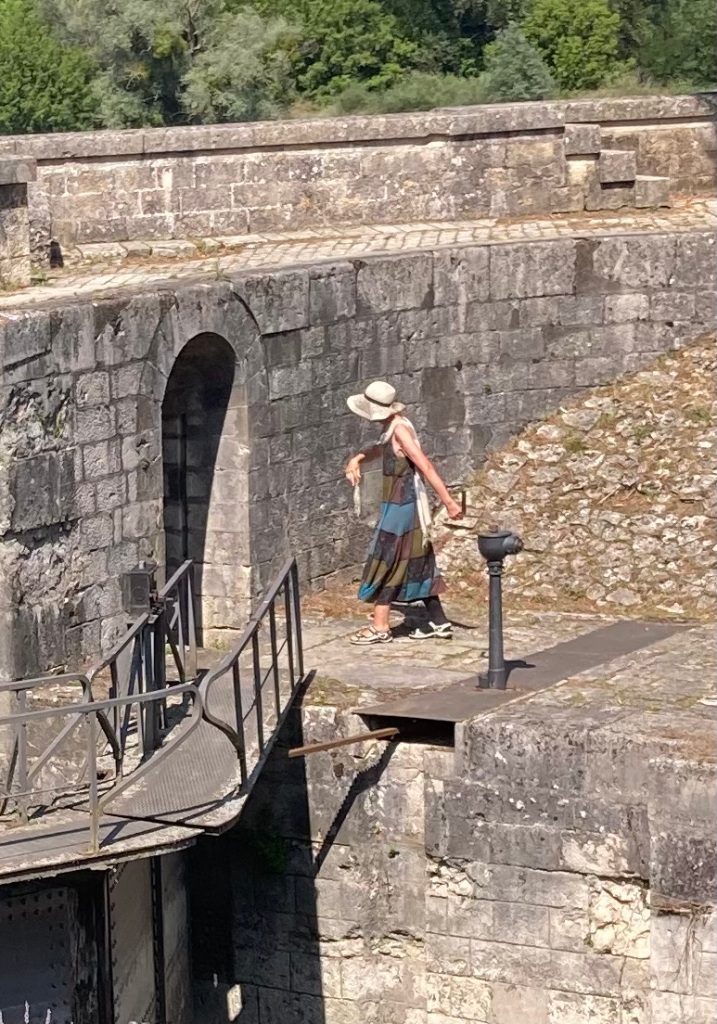
I mentioned there would be more about the old canal and lock onto the Loire. That gave our afternoon walk a special purpose that day. It is a short walk over to see it all.
First you pass by the huge basin where barges would line up and wait for a good day to cross the river – not too much flow or wind! Then we saw the lock itself, a deep lock looking out onto the Loire.
The boats would pick up a pilot here to help negotiate the currents and sandbars on the 6 kilometre journey to the Briare lock on he other side of the big river, before ascending to the Canal de Briare to continue their course to Paris.
Stu found a shady spot to sit and look at the beauty of the river, a tranquil sopace on this summer day. Meanwhile I explored the lock and its ancient arches that allowed éclujsiers to look out and see the comings and goings of barges below.
Below the lock and to one side, on the 200 year old cobbles, was a relic of the tools used to more barges – a means of pulling rope around a roller.

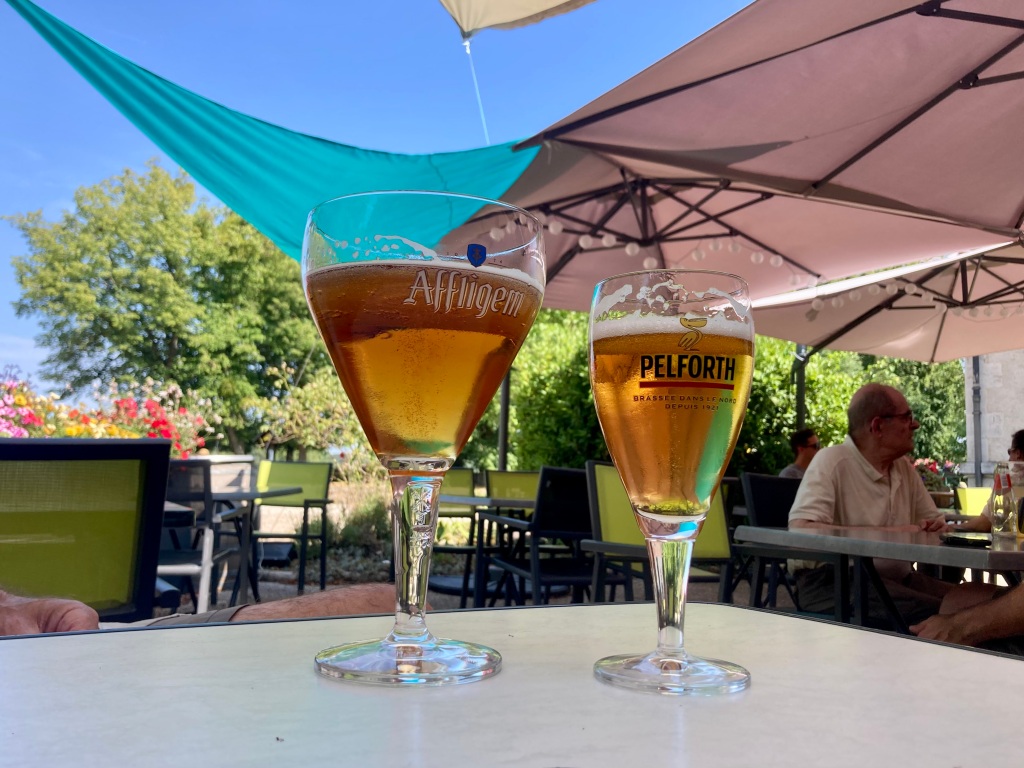
After the exploration the Chambre d’Hôte, restaurant and bar next to the old lock had some very welcome shade and cold beers before we walked back to Calliope..
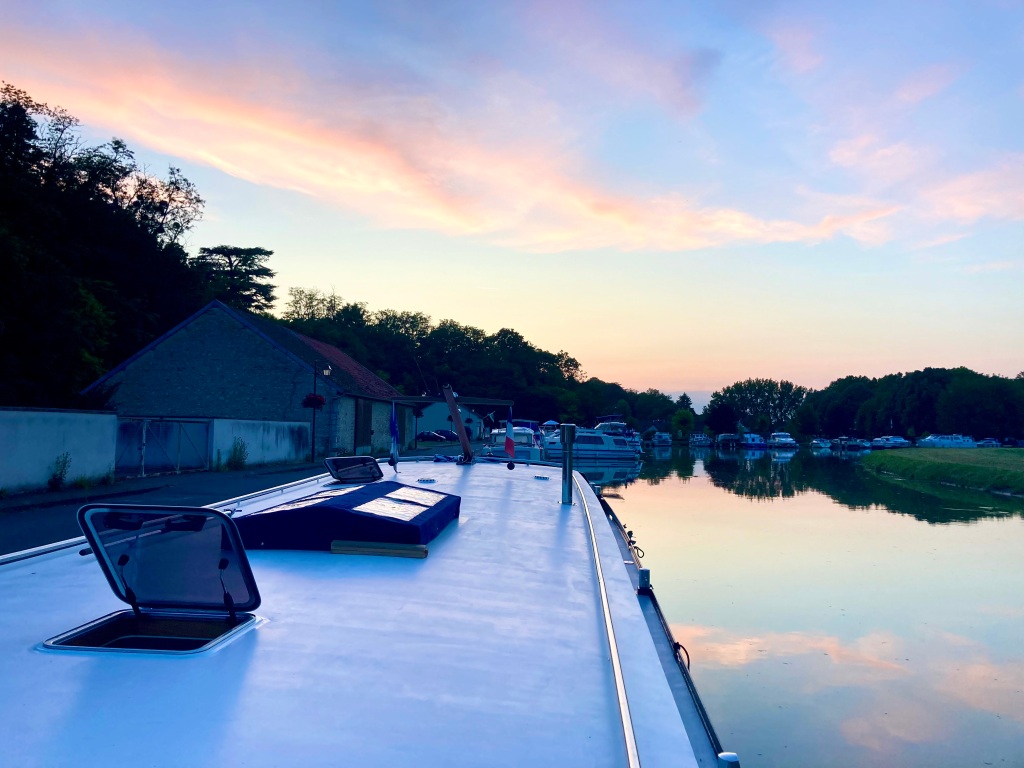
Well before bedtime we were enjoying the shade from the trees alongside the ,boring, and looking forward to an exciting day ahead – crossing the Briare Aqueduct.
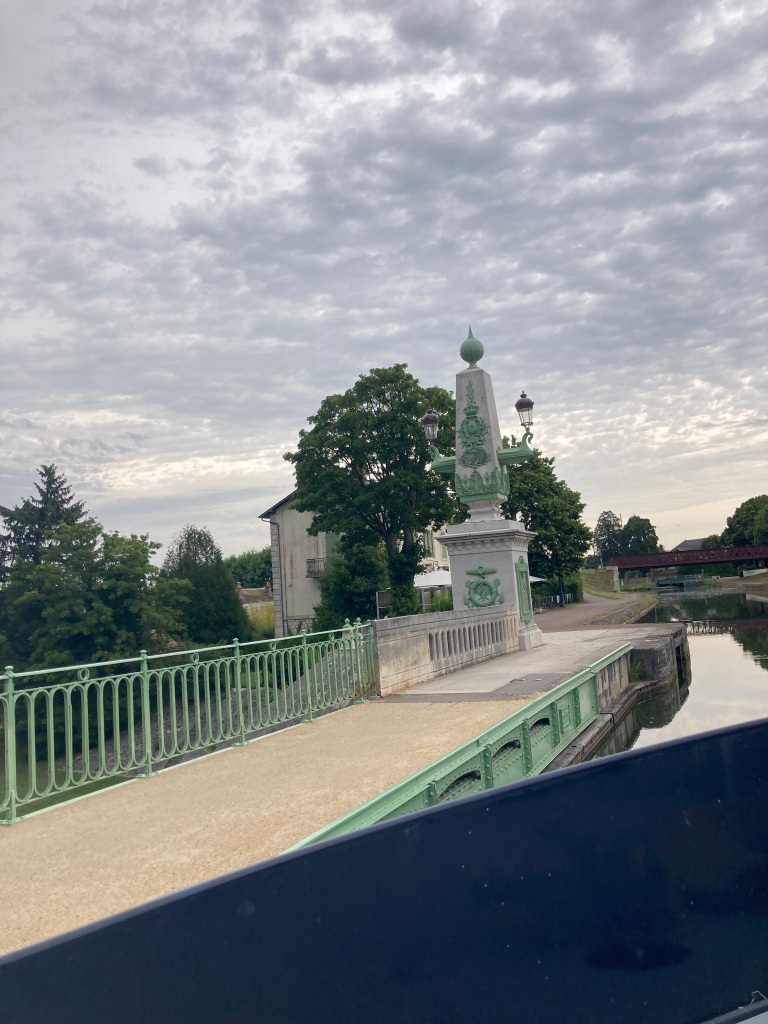
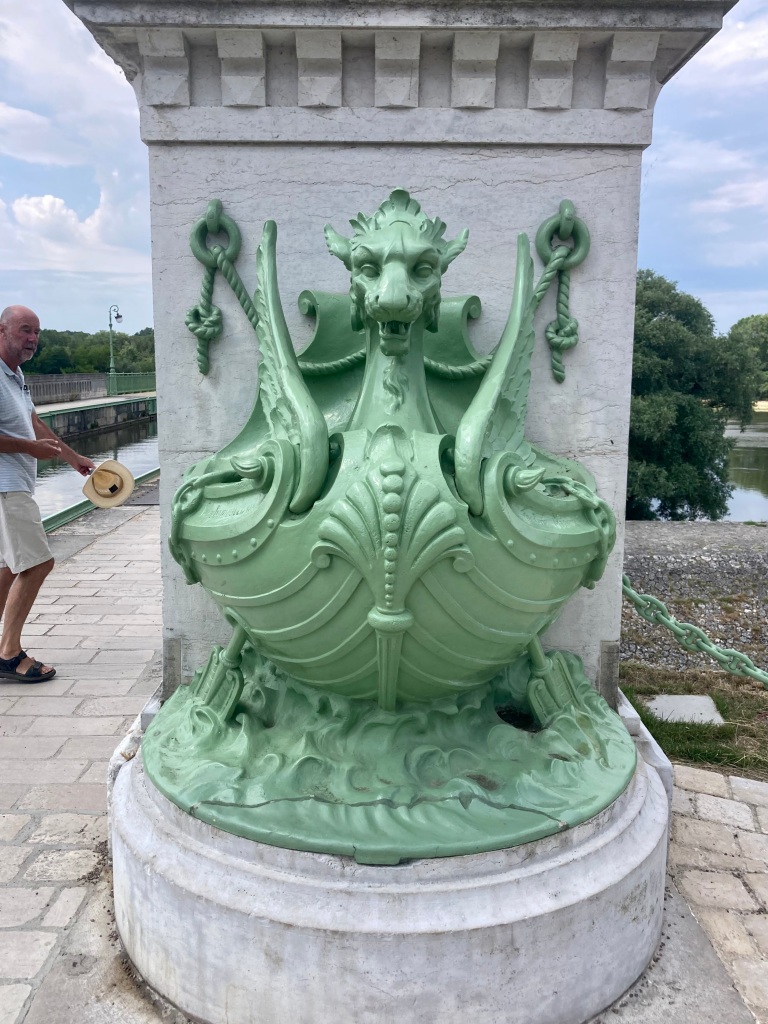
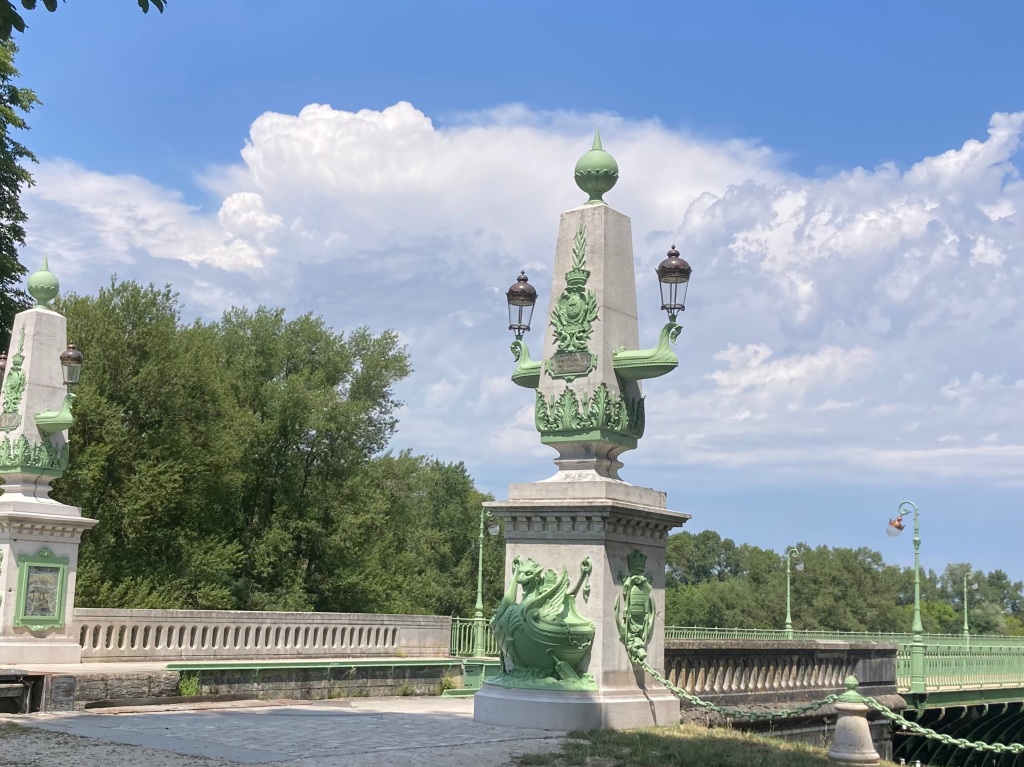
This aqueduct was, for a long time, until 2003, the longest steel canal aqueduct in the world. It is 662 metres long and was designed by the engineers Leonce-Abel Mazoyer and Charles Sigault. The famous Gustav Eiffel was responsible for the masonry abutments and piers.
The aqueduct was inaugurated on 16 September 1896 with the crossing of the boat Aristide, allowing the development of Freycinet gauge transport between the Loire and Seine, ie bigger barges than previously.
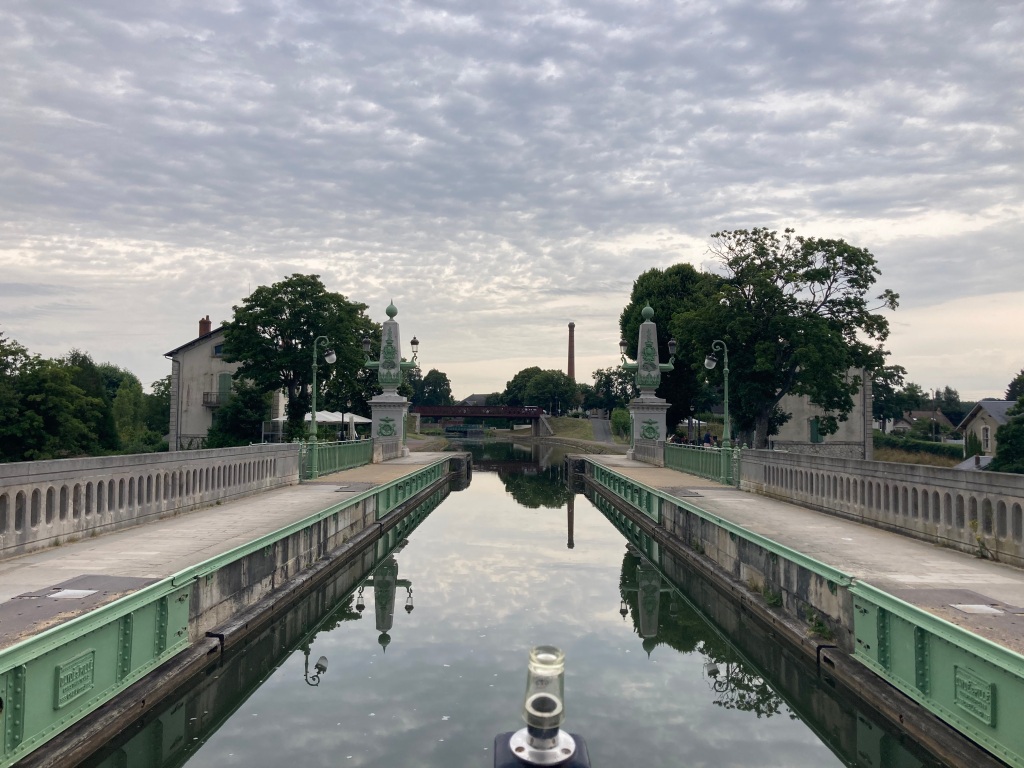
And now it is Calliope’s turn to cross, about 10 years after we walked part way across and dreamt of having our own boat. (Don’t laugh at the little upturned glass over the front flag pole holder – designed to stop spider ands wasp nests!)
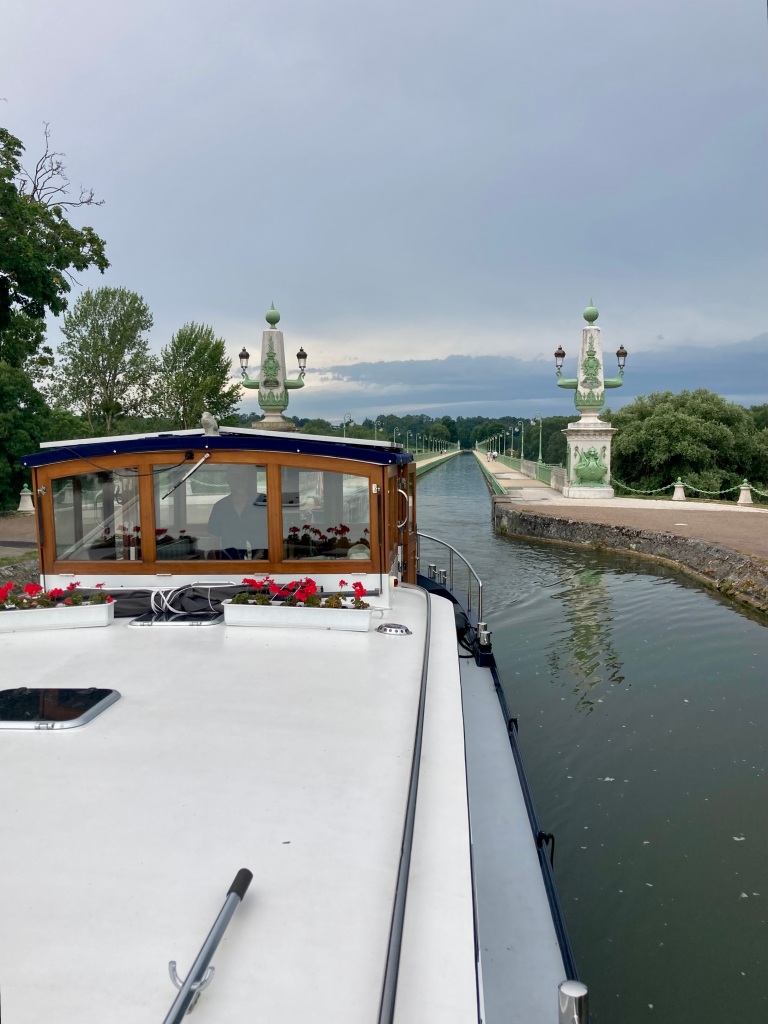
There!
We did it!
Hooray!
How much better for those old barges than having to run the gauntlet of a Loire river in flood
We kind of felt that we had arrived in Briare at this point, but this ‘new’ route to Briare from the other side off the river requires about a further five kilometres, round and above Briare, and then down to the town through a succession of locks.
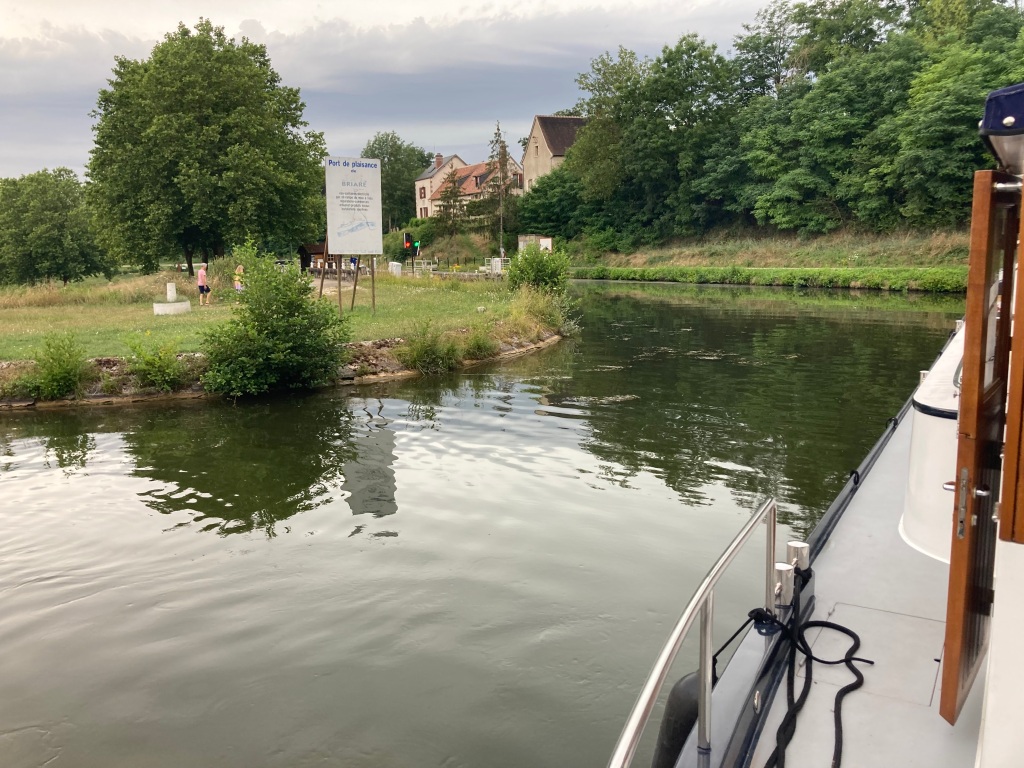
The true ending of the Canal Latèral à la Loire, its 200 PK mark, is where it joins the Canal de Briare at the junction shown above.
To the left is Lock 1 going down into the town. To the right (out of the picture) is where the Canal de Briare leads North towards Paris.
Both are explored in the next blog of our 2023 adventure!
